

content magazine, san jose CONTENT Issue 8.0 Featuring: cinebar | roots & rye | curious Quail | John Warnock | CHuck Geschke | Nadja MArtens |
SHeep
SILICON VALLEY’S INNOVATIVE & CREATIVE CULTURE Explore 8.0 $9.95 display until April 15, 2016
Black
Brasserie

2 N. MARKET STREET, SUITE 100, SAN JOSE, CA 95113 / P: 408.293.4242 / UMBRELLASALON.COM
MOVE IT TO THE NEXT & LEVEL
DKMacademy

MARCH 30 | MARCH 31 | APRIL 1
With our team of coaches, mentors, and investors we get you through a year of material in 3 months.

ACADEMY.DARKKNIGHTMEDIA.COM
(THIS COULD BE YOU.)
DARK KNIGHT MEDIA IDENTITY | PLANNING | SUCCESS
grow YOUR BUSINESS
CCONTENT
Issue 8.0
“Explore”
March / April 2016
The Makers:
Cultivator
Daniel Garcia
Editors
Odile Sullivan-Tarazi
Julianne Jigour, Holly Cooper
Vila Schwindt, Ryan Miller
Circulation/Distribution
Elle Mitchell
Brand Director
Julia Canavese
Production
Kristen Pfund
Publisher
Silicon Valley Creates
Managing Editor
Flora Moreno de Thompson
Designers
Elle Mitchell, Omar Rodriguez
Photographers
Stan Olszewski, Mark Chua
Scott MacDonald
Writers
Mark Haney, Brandon Roos
Chad Hall, Kate Evans
Michelle Runde, Nathan Zanon
Kevin Biggers, David Perez
Lam Nguyen, Leah Ammon
Intern
Arabela Espinoza
I’m not sure whether I became a photographer because I’m the curious type, or whether becoming a photographer has, in fact, made me curious. Either way, one nurtures the other and I’m drawn to finding out more about the people behind the events, the products, and the culture around me.
In this issue, join us in just such an exploration. Share something of what it means to embark upon a new business venture, with Roots and Rye and with Black Sheep Brasserie. Take a behind-the-scenes look at the initial days of Adobe in a conversation with its founders, and tune into the thoughts of five Adobe creatives who are developing tools we may well come to rely upon in future. Experience the joy of wilderness journeying with Ashley Hill, whose zest for living inspires and exhilarates. Through a set of guidelines developed by SPUR, examine the way cities are designed for better walkability, which sparks my curiosity and I hope yours as well. As you meet these people and others, may your curiosity deepen and grow — and may you find yourself compelled to explore.
Enjoy.
Daniel Garcia
The Cultivator
IN THIS ISSUE
Chuck Geschke / John Warnock / Curious Quail / Avery Palmer / The Alameda Artworks
To participate in Content Magazine: editor@content-magazine.com Subscription & Advertising information available by contacting Elle@content-magazine.com

Content Magazine is a bimonthly publication about the innovative and creative culture of Silicon Valley, published by .





Content All materials in Content Magazine are protected by United States copyright law and may not be reproduced, distributed, transmitted, displayed, published, broadcast or modified in any way without the prior written consent of Silicon Valley Creates, or in the case of third party materials, the owner of that content. You may not alter or remove any trademark, copyright or other notice from copies of this content. For further information, or to participate in the production or distribution, please contact us at editor@content-magazine.com
March/April 2016 San Jose, California
Adobe Founders, pg. 46
Day Trip 8 Monterey Bay, Ca CULTURE 10 Let’s Walk ART & Design 14 Screenprint Showdown Winners 16 The Alameda Artworks, Falko Forbrich 18 Artist, Avery Palmer 22 Artist, Nadja Martens 28 Photographer, Josh Marcotte 32 Spartan Film Studios, Barnaby Dallas 36 The Core Companies, Chris Neale Profiles 40 Heroes Comic Books, Alan Bahr 42 Trekker, Ashley Hill 46 Adobe Founders, Chuck Geschke & John Warnock 52 Inside Adobe: Profiles food and drink 58 Roots and Rye, Chris & Julian Yeo 62 Black Sheep Brasserie, Stephen Shelton, Philippe Breneman, Jimmy Marino & Don Durante 66 Cinebar, Josh Hanoka, “Mad Mike” Matilainen & Stacy Sutherland Style 68 At the Fairmont, Daniel Garcia Writing 78 Cupertino’s Poet Laureate, Amanda Williamsen Music 80 Curious Quail 82 Content LAB 84 Content Calendar 86 Cinequest Survival Guide 87 Content Partners 94 Content Contributors
At the Fairmont, pg. 68
Roots and Rye, pg. 58
EXPLORE 8.0
Artist Nadja Martens, pg. 22

Need an escape? Don’t have a lot of time? Living in Silicon Valley provides you with all kinds of options for a short getaway. From the beach to the mountains, wineries to windsurfing, the South Bay is one of the best hubs for launching into world-class scenery and activities. So why not take a day trip?
Monterey Bay, Ca.
Written by Joey Nguyen
Photography by Daniel Garcia
You always have plenty to see and do in Silicon Valley. But sometimes you just need to get out of town and off the grid. A drive to Monterey Bay can be just the fix. With views of the Pacific Ocean and untouched coastal landscapes along the Coast Highway, even the journey to Ocean Avenue—Carmel-by-theSea’s main street—is part of the adventure. You get there from Silicon Valley by taking US-101 South to CA-156 West to CA-1 South, or take the more scenic CA-17 South to CA-1 South.
Begin your day in the Monterey Bay Area at La Bicyclette, arguably one of the best restaurants in Carmel. Toward the back of the restaurant, you’ll find a wood-fired oven where the staff prepare a handful of their breakfast plates. If you want a little taste of everything, you can’t go wrong with the Sweet & Savory dish: French toast, eggs—and don’t forget to order it with a side of bacon.
After you’ve filled your belly, grab a cup of caffeine from the Carmel Coffee & Cocoa Bar. You can easily spend the day taking a leisurely stroll and shopping in Carmel. It may be a small town, but the streets are jam-packed with boutiques and art galleries. One place truly worth visiting is the Cottage of Sweets, a candy shop straight out of a fairy tale, that
appeals to kids and adults alike.
If you’d prefer to get more exercise, head south on Highway 1. Head toward Point Lobos State Natural Reserve where you can take in the views and be as one with nature. The drive from Carmel through Point Lobos and continuing all the way to Big Sur is one of the most beautiful stretches of Highway 1. Spend a couple hours exploring the park and its many hiking trails. When you’re done, it’s probably time for lunch, and you’ll want to make it a healthy meal. Drive back north on Highway 1 and into Pacific Grove, where you can replenish your body with a fresh cold-pressed juice at Central Coast Juicery. Then grab a poke bowl at The Poke Lab, a few blocks away in Monterey. These are great ways to replenish all those calories you worked off during your hike.
A trip to Monterey Bay is not complete without a visit to the world-renowned Monterey Bay Aquarium. You’ll see real-life sea otters in action. For a preview, check out the video the Aquarium has posted on its website of a day-old wild pup with its mother. After you’ve toured the exhibits there, check out the shops on Cannery Row, a historic area made famous by author John Steinbeck. Then make your way to dinner at the nearby
Jeninni Kitchen + Wine Bar for tasty Spanish fare and excellent wine choices. Call ahead to find out if paella will be featured. Otherwise, the eggplant fries, prosciutto plate, shawarma, and bullfighter’s steak are always superb.
If you’d rather enjoy your dinner in Carmel, stop in at Grasings to start off with a cocktail in an intimate setting. Then head over to Il Tegamino for a great homestyle Italian meal— the Ragu Napoletano is highly recommended. The Monterey Peninsula is world-famous for its many golf courses. Whether you’re a golfer or you just want to see what all the fuss is about, visit The Bench, a restaurant and bar overlooking Pebble Beach Golf Links. Enjoy some drinks and small plates, and take in the scenery at the famous 18th hole.
If you’ve planned on staying the night, try a room at the Carmel Valley Ranch, which features a luxurious spa. Other amenities at this resort that make it worth your while are onsite beekeeping, s’mores at night for guests, and more, depending on the season.
Monterey Bay is a tranquil, incredibly scenic coastal destination. It’s easy to get to, provides a break from the buzz of Silicon Valley, and offers great food and drink. Head there once, and you’ll soon be making plans for your next trip back.
10
Day tri p 408
Welcome to Monterey, CA Population: 28,294
A waterfront community on the central coast, Monterey enjoys a temperate climate year-round, making it the perfect spot for kayaking, scuba diving, surfing, whale watching, and other activities on the beach and in the water. Monterey is home to historic Cannery Row, associated with author John Steinbeck, and the world-renowned Monterey Bay Aquarium, situated directly on the ocean.
La Bicyclette
Dolores St at Seventh Ave
Carmel-by-the-Sea, CA 93921 831.622.9899
Carmel Coffee & Cocoa Bar
Carmel Plaza, Ocean Ave and Mission St
Carmel-by-the-Sea, CA 93921 831.238.6478
Cottage of Sweets
Ocean Ave, between Lincoln St and Monte Verde St
Carmel-by-the-Sea, CA 93921 831.293.9488
Point Lobos State Natural Reserve 62 CA Highway 1

Carmel-by-the-Sea, CA 93923 831.624.4909
Central Coast Juicery 206 Forest Ave Pacific Grove, CA 93950 831.747.7085

The Poke Lab 475 Alvarado Street Monterey, CA 93940 831.200.3474

The Monterey Bay Aquarium 886 Cannery Row Monterey, CA 93940 831.648.4800

Jeninni Kitchen + Wine Bar 542 Lighthouse Ave Pacific Grove, CA 93950 831.920.2662

Grasings Sixth Ave and Mission St Carmel-by-the-Sea, CA 93923 831.624.6562
Il Tegamino
Ocean Ave, between Lincoln St and Monte Verde St
Carmel-by-the-Sea, CA 93921 831.250.5790
The Bench 1700 17 Mile Dr Pebble Beach, CA 93953 831.624.3811
Carmel Valley Ranch 1 Old Ranch Rd Carmel-by-the-Sea, CA 93923 831.625.9500
11
The Poke Lab
Jeninni Kitchen + WIne Bar
The Monterey Bay Aquarium
Point Lobos State Natural Reserve
Central Coast Juicery
Let’s Walk
Written by Benjamin Grant, Urban Design Policy Director, SPUR
Imagine you’re heading out with a friend or colleague, and they make that suggestion. You probably know immediately if it’s worth considering or if your friend has taken leave of his or her senses. But how do you know? We tend to assume it’s a matter of “walking distance,” a subjective and malleable measure, usually somewhere between a quarter-mile and a mile. But in reality, the physical qualities of a place—and feelings of comfort, safety, interest, and convenience—are every bit as important.
Whether people walk or not is a matter of some importance. It affects rates of obesity and chronic disease, greenhouse gas emissions, the viability of public transit, the amount of traffic, and the need for parking. And it affects the quality and cost of our day-to-day lives.
Fortunately, we know what makes a place walkable. It can be understood, measured, and made part of the rules and codes that shape our cities. “Walkability” is excellent shorthand for good urban design. For a city to encourage walking, it must have a dense mixture of land uses, integrated with streets and open spaces, all designed for people.
Walkable places are comfortable, convenient, healthy, and sustainable, but they can be very difficult to achieve—especially in suburban environments that were designed for driving. These images were developed as a simple reference for planners and builders trying to retool car-oriented suburbs for walkability. It’s part of a bigger effort to change the rules and practices that shape our cities so more us can answer, “Sure, let’s.”
Illustrative graphics by Gensler. Thanks to Lewis Knight, Jim Zhao, and Xiao Wu.
Photographs by Sergio Ruiz, Benjamin Grant, Landscape Architecture Foundation, Callison LLC, New York City Department of Transportation, Forest City, and google
WALKABILITY PRINCIPLES


The following seven principles, developed for SPUR’s 2013 report Getting to Great Places, distill the most critical ingredients of walkable urban districts. We give examples of “typical,” “better,” and “best” conditions, paired with illustrative images. All of the case studies described on this site embody these principles, which apply at a variety of scales and densities—from small-town neighborhoods to big-city downtowns.
TYPICAL best better
1Create fine-grained pedestrian circulation.
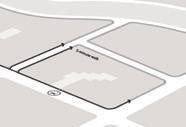

Frequent and densely interconnected pedestrian routes are fundamental to walkability, shortening both actual and perceived distances. This can be accomplished by making city blocks smaller or by providing access through blocks via publicly accessible alleys, pathways, or paseos (pedestrian boulevards) coupled with frequent crosswalks. A good rule of thumb is that a comfortable walking environment offers a choice of route about once per minute, which is every 200 to 300 feet at a moderate walking pace—typical of a traditional, prewar city block. This not only allows pedestrians efficient access but also provides visual interest and a sense of progress as new structures and intersections come into view.
This kind of “permeability” sometimes meets with resistance from developers and property owners, who may cite security, property rights, or site-planning concerns. But street networks are fundamental to walking. Walking five 200foot blocks through Portland, Oregon, is easy and comfortable. Walking the same thousand feet on a typical suburban commercial street—past a single distant building and no intersections, for example—can be very uncomfortable.
A major statistical analysis found that intersection density and street connectivity are more strongly correlated with walking than even density and mixed land uses. Only proximity to the city center has a stronger effect.

TYPICAL best better
2Orient buildings to streets and open spaces.


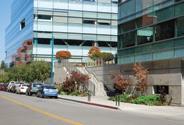




In walkable urban environments, buildings are placed right at the edges of streets and public spaces, rather than being set back behind parking lots or expanses of landscaping. These built edges provide a sense of definition to streets and other spaces, which helps makes the environment more legible and coherent. At all scales, from big-city downtowns to small neighborhood centers, edges help reinforce circulation routes while allowing easy pedestrian access to buildings. Building entrances are on or next to sidewalks. Setbacks from the street are short and exist only to provide public space or a transition from public to private life.
Where buildings are set back behind parking lots or landscaping, pedestrians are isolated from buildings, exposed to traffic and forced to walk greater distances. Even if a walking path or sidewalk is provided, pedestrians and transit users receive the message that they are of secondary importance. Loading docks, service entrances, blank walls, and driveways should be limited in size and located far away from walkways and entrances.
13
3
Organize uses to support public activity.
The way uses are arranged on a site has a major impact on the activity, vitality, security, and identity of surrounding streets and spaces. Active uses (such as retail, lobbies, and event spaces) should be placed strategically along pedestrian routes to engage the public and should be designed for transparency and interest. Secure, private spaces should be placed at site interiors, away from public streets.
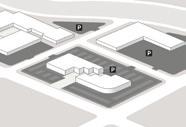

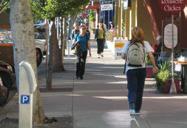




Residential entrances should be designed to provide a graceful transition from public to private. Stoops, front porches, balconies, and lobbies can all provide privacy while supporting sociability and greater security by increasing the number of “eyes on the street.”
Certain uses, such as garages and cinemas, should be tucked deeply away, but their points of access can be major nodes of activity. Loading and utility spaces should be hidden from pedestrian frontages.





TYPICAL best better
4
Place parking behind or below buildings.


In newer development, good places for people depend heavily on the artful accommodation of cars. Parking is an expensive, space-hungry, and unattractive use. It should be provided in multilevel structures where possible and placed where it will not disrupt pedestrian spaces. Well-designed garages can serve multiple buildings, draw people onto streets, and allow parking to be managed efficiently. Once they have parked, every driver becomes a pedestrian, so pedestrian garage exits should be located to support and enliven public spaces.




TYPICAL best better
5
Address the human scale with building and landscape details. People experience the built environment at the scale of their own bodies in space. Buildings should meet and engage people at that scale, with awnings, façade elements, lighting, signage, and other features along sidewalks. Building forms can be broken down or subdivided visually to lighten the sense of mass. Even very large buildings can meet the human scale in a gracious and accommodating manner.
TYPICAL best better

14 Office Retail Residential Parking Public Open Space Underground Parking Above Ground Parking
TYPICAL best better
6Provide generous, comfortable pedestrian space.



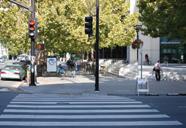

Wide sidewalks that include elements like trees, lighting, street furniture, and public art are the city’s connective tissue. In great walking cities like Barcelona and New York, sidewalks 40 feet wide are not uncommon, but a well-designed 10-foot sidewalk can be adequate in some contexts. Sidewalks should form a continuous network connected by frequent, safe street crossings. Sidewalks, while fundamental, are only one part of the broader public realm. They should be seamlessly integrated with walkways, paseos, building entrances, transit facilities, plazas, and parks. In order for people to feel comfortable walking, the continuity of pedestrian access is essential on all parts of their route.
TYPICAL best better
7Build complete streets.
Streets can accommodate a variety of travel modes while also serving as public amenities, sites of commerce, and green spaces. Vehicular roadways should be no bigger than necessary for their function, and they should apportion space safely among private vehicles, transit, bicycles, and parking. If they are well designed, streets can move significant volumes of auto traffic and still support other activities. Small streets are equally important and can limit vehicular speeds and capacity in the service of other functions, from deliveries to social activity.



FROM THE CITY OF SAN JOSE’S ENVISION 2040 GENERAL PLAN: “A complete street provides safe, comfortable, attractive, and convenient access and travel for pedestrians, bicyclists, motorists, and transit users of all ages, abilities, and preferences. The design of a complete street considers both the public right-of-way and the land uses and design of adjoining properties, including appropriate building heights and the planning of adjoining land uses that actively engage the public street realm.”




SPUR.org designforwalkability.com 15
SCREENPRINT SHOWDOWN DESIGN CONTEST






In the months preceding the final event on January 30 of this year, the Screenprint Showdown engaged San Jose with one question: What’s your San Jose? With each original submission to the design contest, a new and modern visual identity was created for the city. An identity, in each case, spun out of the designer’s visual realization of their own San Jose experience. And their vision for the future.
Here are the four winning finalists of the Screenprint Showdown Design Contest (In no particular order)
PALETERO SJ

Artist: Corinne Takara
Current city: Cupertino
Paleteros can be seen in so many parts of San Jose, from Japantown to Mayfair and Alum Rock. I thought that such carts captured a sense of the familiar and cheerful texture of San Jose neighborhoods. So much of San Jose's creativity arises from thinking outside the box and from blending things in new ways. I tried to visually allude to this blending and mixing with the range of varied elements rising and swirling from the freezer box. social media: corinnetakara
ScreenPrint Showdown Partners:
FALCON OF SAN JOSE #1

Artist: Dasol Hong
Current city: New York
I took the inspiration for this piece from Clara, a rare peregrine falcon who since 2007 has made her springime home a nestbox located on top of a ledge on the 18th floor at City Hall.
Art/Design Professional
instagram: davinah1988
SAN JOSE EXPLOSION

Artist: Kent Huang
Current city: San Jose
An explosion of San Jose and the love for it. We have the airport, City Hall, local sports, museums, transportation, zoo, Japantown, and more all mashed up with tech driving the city. An eclectic mix for all.
Art/Design Professional
ROCKIN' RIDE
Artist: Shannon Knepper
Current city: San Jose
After having lived in biking cities like Portland and Pittsburgh, I moved to San Jose and immediately felt at home with its thriving bike culture—and the bikers pumping music from their rides!
Independent Artist/Designer
twitter: waradmiralpress
screenprintshowdown.com
17
THE ALAMEDA ARTWORKS
San Jose was once home to a wealth of artist communities. Shared spaces of all shapes and sizes, bustling hives of activity, could be found scattered through neighborhoods across the city. If you were in the art scene, on any given weekend you might find yourself at an impromptu gallery show or a musical performance. This was the spirit of the scene, and many of San Jose’s most talented artists and musicians developed their styles and followings amid the fertile creative landscape. That was then. This is now.
Two decades’ worth of staggering economic growth and skyrocketing real estate prices has effectively shut down most of these communities. It has simply become too expensive to provide studios for artists at reasonable prices, and as a result many artists can no longer afford separate creative spaces. The Alameda Artworks is a notable exception. Not only has it staved off the pressures of a neighborhood that is being steadily gentrified block by block, it thrives also as one of
San Jose’s last strongholds of artistic creativity.
After purchasing the building that houses the Artworks in 1991, Falko Forbrich made it his mission to maintain affordable spaces for artists. “Since I am involved in real estate, I see an opportunity to help the artistic community and support them. By buying the properties, I have more control over the use and payments. Now I am able to provide a good place for artists,” says Forbrich, for whom freedom and artistic expression have been lifelong passions. Having lived through, and eventually escaped from, the oppressive regime in East Germany, Forbrich wanted to foster creativity concretely. “I like art and have seen many artists with good talent and artistic values who couldn’t afford to pay the rent on their studios, so I wanted to provide an affordable place for them.” It is a legacy he is now passing on to daughters Alicia and Natasha.
The Alameda Artworks embodies the spirit of the man who founded it. Patti Linder-Dodd, a resident of the
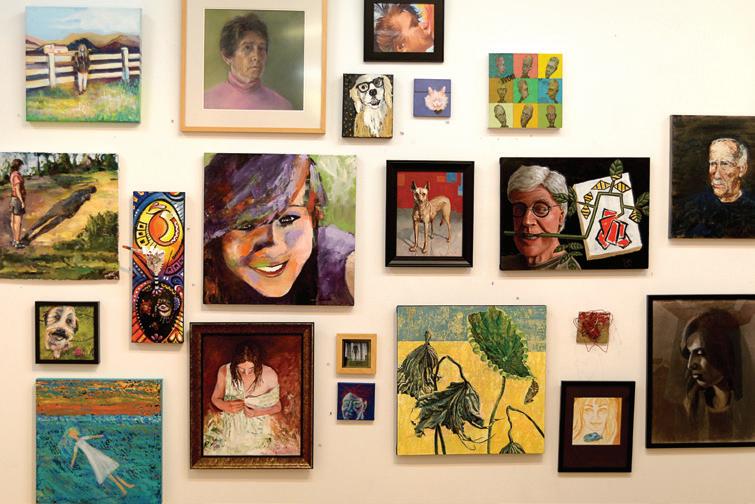
18
Article and Photography by Lam Nguyen
Artworks for over 20 years, says that she and the other artists work to maintain the atmosphere and environment Falko instilled. “We’re all very supportive of each other and work hard to help each other,” she says. “Falko, and now Natasha and Alicia, have always left it to us [the artists] to decide who fits best with us. This way, we’re able to pick artists with personalities that mesh well with us.”
Most of the artists that occupy The Alameda Artworks have been there for years. Others, like Christine Bunz, a mixed-media contemporary artist who is heavy on social commentary, have had to wait for a space. “I was in line for four years for my spot and was ecstatic when I got it,” she says. After many years in Hollywood as a set painter, Bunz went in search of an environment where she could freely express her political views through her art. She found that environment at the Artworks. “I can be me and do whatever tickles my heart or catches my eye,” she explains. “Painting for other people paid my bills, but painting for myself fills

my soul, and you can’t put a price on that.”
Bunz shares a wall with Lucy Liew, an artist who could not be more different in style, sensibility, or personality. Primarily a painter, Liew is much more about capturing an intimate closeness with nature. “I find things that most of us take for granted in nature and capture them,” says Liew. “To me, the closeness gives you a different appreciation for the beauty in nature.” Different as they are, Bunz and Liew coexist as part of the tight community that is the Artworks.
The Alameda Artworks has always been a family business, and Natasha and Alicia Forbrich, now the primary caretakers of the facility, want to keep it that way. “We plan to keep the AAW open as long as possible and to continue to take care of it the same way that our father has over the past many years,” says Alicia Forbrich. “We grew up around the AAW, so it’s been part of our lives for as long as we can remember. The artists are not just our friends, they are our family members.”
thealamedaartworks.com 19
Not only has the Artworks staved off the pressures of a neighborhood that is being steadily gentrified block by block, it thrives also as one of San Jose’s last strongholds of artistic creativity.

“SOMEHOW, I FELT LIKE I HAD GROWN AS AN ARTIST. WHEN I WENT BACK TO PAINTING, I COULD PAINT IN A WAY THAT I COULDN’T BEFORE.”
AVERY PALMER
INK, PAINT, AND CLAY
Written by Michelle Runde Photography by Daniel Garcia
Many artists focus on only one type of media for their entire career, but Avery Palmer isn’t like most artists. He has delved deeply into painting, drawing, and ceramic sculpting throughout different phases of his life. Inspired by surrealist painters such as Salvador Dali, his figurative art presents cryptic metaphorical scenarios exploring the complex nature of human existence. In his artist’s statement, he says, “I invent scenarios that can be thought of as puzzles with no right or wrong solutions—and perhaps no solutions for them at all.” His fantastical and often eerie creations can evoke a wide array of reactions, but that is what makes them so compelling.
Palmer was born and raised in Humboldt County. He recalls his first experiences creating art: “For as long as I can remember, I always drew. As a kid, I was really into airplanes, cars, stuff most boys like. I would try to capture the essence of that thing as I saw it.” In addition to drawing, he was also a Lego lover, building new creations constantly. “Related to sculpting, Legos may have started me out,”
Palmer muses. “You can make what the instructions say or let your imagination run wild.”
After graduating from high school, Palmer was accepted to Humboldt State University (HSU), where he pursued his bachelor’s degree in studio art. He drew exclusively until halfway through college, when his work developed into oil painting. At the same time, he enrolled in a ceramics class, which he found he preferred. “I was frustrated [with painting] back then because I couldn’t replicate what was in my head,” Palmer acknowledges. “I found ceramics to be more intuitive. It was easier to take the 3D image in my head and create it out of clay. With painting, it’s more difficult.” His newfound passion for sculpting led him to enroll in a ceramics course every semester afterward.
As graduation approached, Palmer was excelling in ceramics. “My professor was asking me what I planned to do, but I didn’t know exactly yet,” Palmer says. “He recommended that I enroll in honors ceramics.” This class could be taken independently even after graduation, and

21
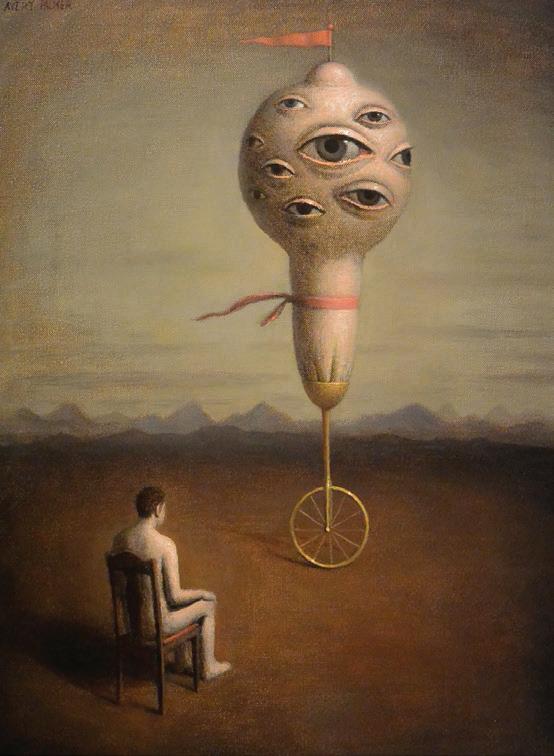


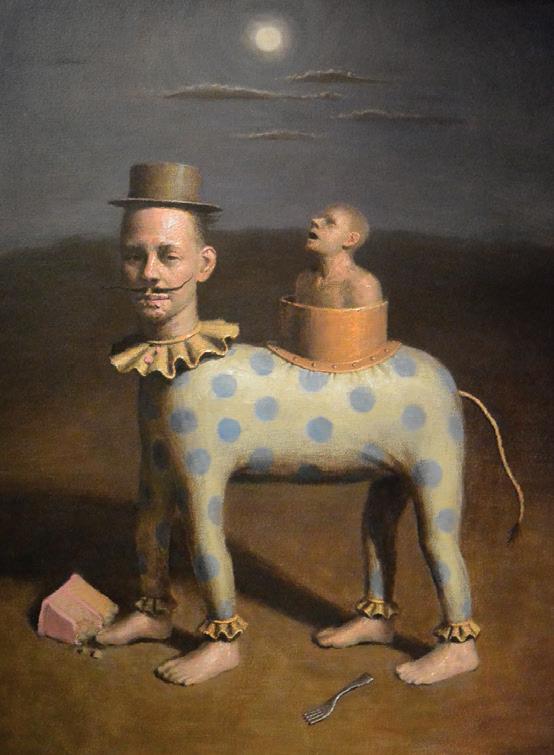 Lunacy
Lunacy
The Visionary Twins 22
Man with Donut
Palmer ended up taking the class multiple times over the next few years. Without the pressure of his college studies, Palmer spent his day at the campus studio, living and breathing his work.

HSU participates in the California Conference for the Advancement of Ceramic Art (CCACA), and Palmer was asked to represent the university. The CCACA is held at the John Natsoulas Gallery in Davis, California. Not only was the conference a place to showcase his work; it was also a place to network and sell. “It was my first introduction into a ‘market’ where I could actually sell my work,” Palmer says. “It got me serious about thinking of my art as a career.” After he’d attended the conference multiple times, the John Natsoulas Gallery approached Palmer to offer to officially represent him as an artist. They would showcase his art locally and at various galleries around the United States. Palmer accepted and is incredibly grateful for this partnership: “It was nice to know my work would get out there and be seen by more people.”
Three years after graduating from HSU, Palmer was accepted
to the master’s program for spatial art at San Jose State University (SJSU). Palmer was focused solely on sculpting, but because SJSU’s art program encouraged students to explore various media, he picked up his paintbrush again. “I didn’t experiment a lot, but I found my way back to drawing and painting about halfway through my master’s,” Palmer says. “By the time I left, I was focusing solely on painting. My ceramics were feeling a bit repetitive. Somehow, I felt like I had grown as an artist. When I went back to painting, I could paint in a way that I couldn’t before.” His paintings, like his sculptures, capture his fascination with the human condition, each piece a riddle for the viewer to solve.
Today, Palmer is preparing for an upcoming solo show in March at the John Natsoulas Gallery, and some of his paintings and drawings can be seen locally at the Kaleid Gallery in San Jose. Even though he’s focused on oil painting exclusively now, it was ceramics that helped take his painting to a new level, and his love of it is far from gone.
natsoulas.com/artists/avery-palmer

averypalmerart.com
Lullaby
23
The Hungry Boy
NADJA MARTENS OUT OF THE WOODS
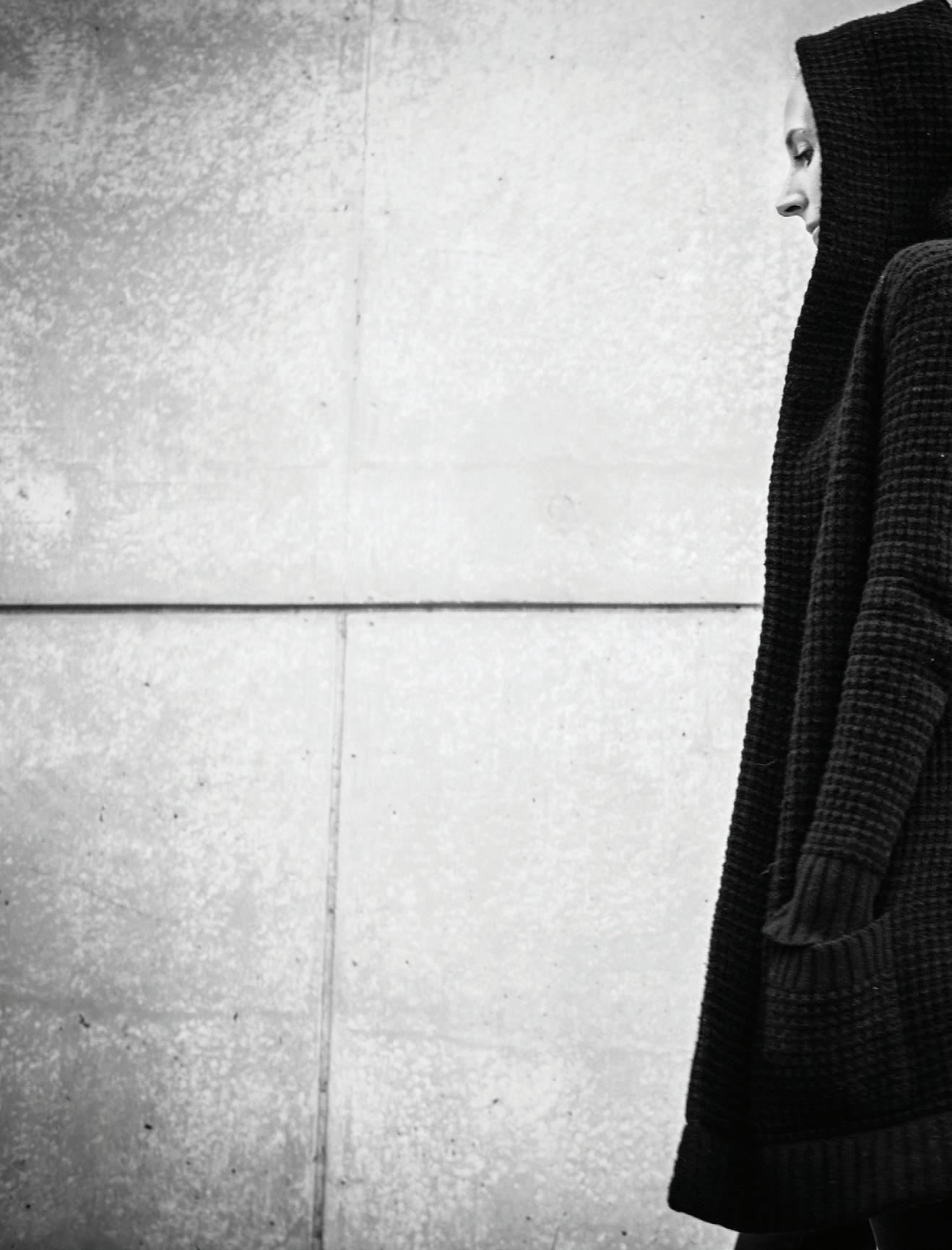 Written by leah Ammon Photography by Daniel Garcia
Written by leah Ammon Photography by Daniel Garcia
An artist whose output is constantly evolving, Nadja Martens is a consummately thoughtful communicator. Her work—rooted in her childhood influences and her prescient observations about individuality, self-confidence, and society is whimsical, humorous, and mysterious.

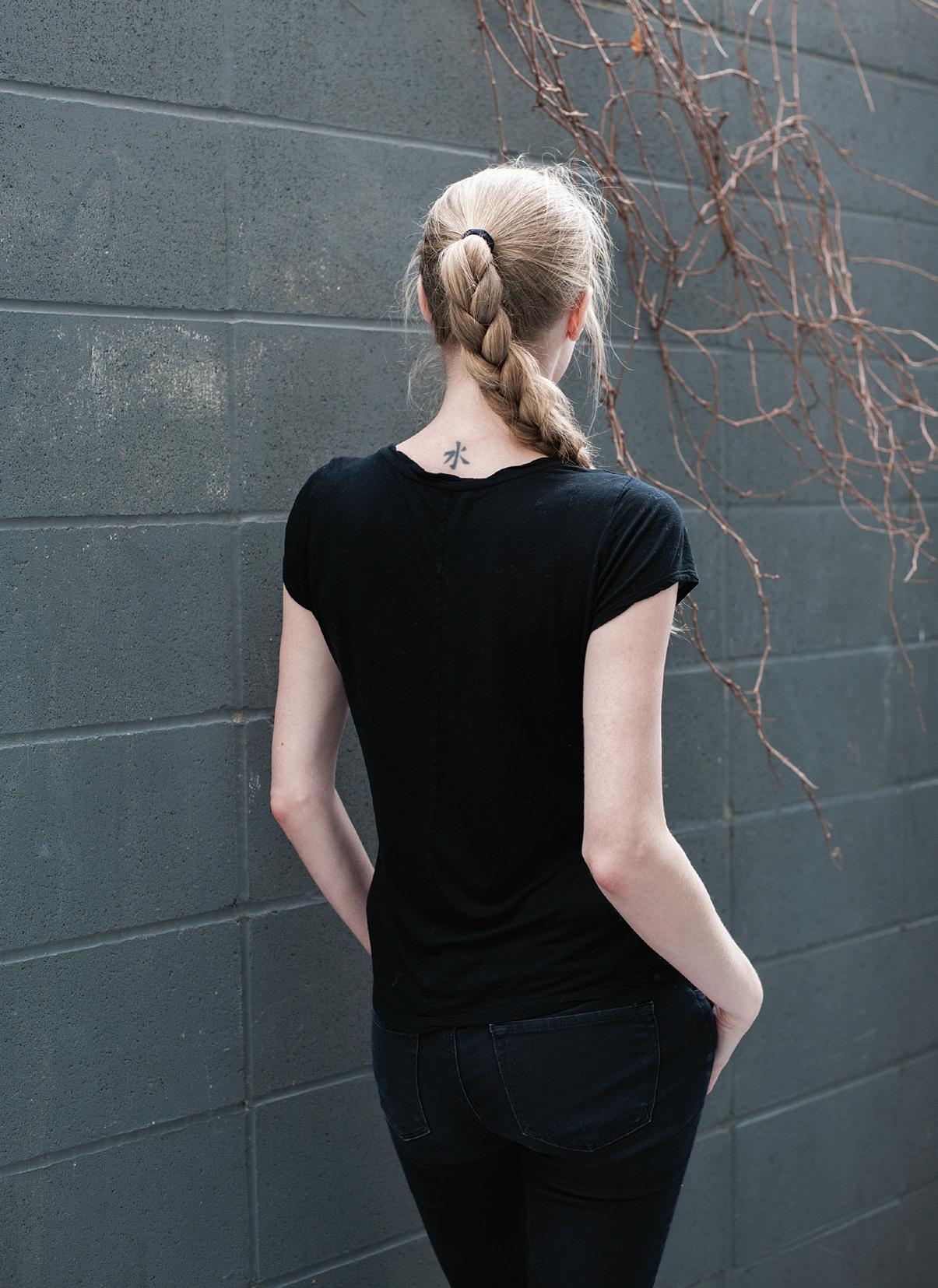


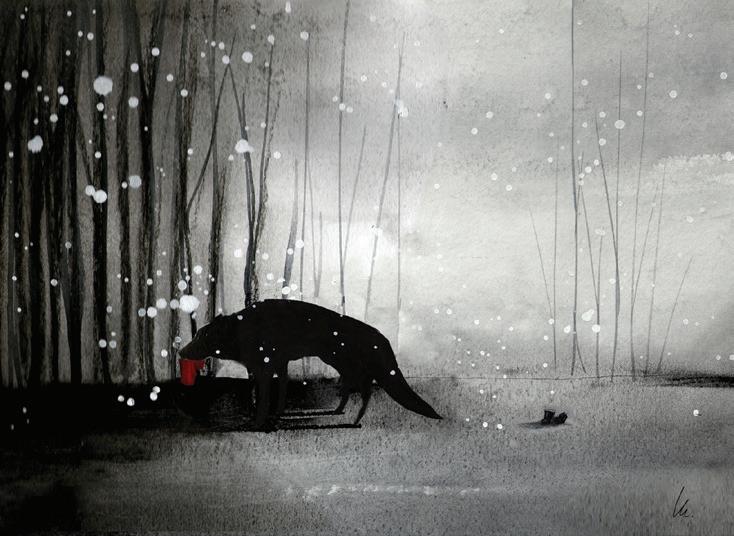
The First Touch In Denial A Tragedy
Nadja Martens hails from northern Germany, more specifically, the outskirts of Hamburg, where she was raised in the forest by her grandparents. She recalls wandering the woods in the company of the family’s two dogs, entranced by the mystery of the landscape. “Everything entertained me. The moss, the trees. I think it was the best time of my life.” The Grimm Brothers’ fairy tales her grandmother told her and the animals she encountered would all go on to fuel her output many years later.
A creative child who always enjoyed art projects, it was not until she reached her 20s that she realized an artistic career would be her calling. She had attended business school in Germany, and later came to the United States as an au pair. As part of that program, she first took art classes at a local university—and that was when everything began to click.
Experiences working with children flavor her work to this day. “I like to look at children,” she says. “I like observing how they interact with the world around them.” Born of this sensibility is her best-known work: a series of multimedia pieces reflecting on Red Riding Hood’s encounter with the wolf. “You tell children not to touch the dog and what are they going to do?” she asks with a rueful smile. “They’ll touch the dog. Of course, until they get bitten.”
As is typical with Martens’s output, there are many levels on which the Red Riding Hood series operates. “It’s something like facing yourself,” she says, “and your darker impulses. I think there is a way you can satisfy both sides and confront your fears.”
After concluding her stint as an au pair, Martens committed to her art full-time, taking arts practice classes at Foothill and De Anza colleges. She also began to dabble in other disciplines, especially philosophy and psychology. “It helps with developing concepts for the paintings,” she says, “and understanding yourself.”
These principles are at play in another of her popular works, Snow-White & Rose-Red, depicting sisters from another fairy tale. “My paintings often reflect situations in my life that I’m perhaps not aware of. The way this work is painted, it’s really cut,” Martens observes. “I recall that at the time I wasn’t really in tune with myself. I wanted to be, but I couldn’t be.” She pauses, “And I think that’s something people can relate to. We all, at times, feel separated from ourselves.”
Her more current work—including her collection Walk with Me Where No One Follows, recently exhibited at San Jose’s Kaleid Gallery—further reflects on these themes.

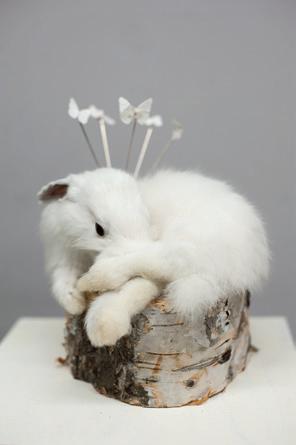
“I like to paint animals because they always represent something,” she says. Describing a work from that show, The Departure, she says, “Here, the bear is courage and strength. It’s a story about having faith in yourself.” She continues, “People always like to tell you ‘You need to do this. You’re reaching a certain age,’ you know? Trying to enforce all the social norms. And they may not apply to you. It can be hard to trust yourself and go with it, but you have to have faith in yourself.”
Of her creative process, Martens insists that everything is just that: a process. “Art is not a talent; it’s a practice.” She confesses, “I don’t think of my paintings as being perfect or finished. There is so much room to change and improve, always, and it’s really hard to let go. You fail all the time, you know, but you improve. Mistakes give you an opportunity to reflect.”
“I hope that I get to the essence of feelings we all share,” she says. “When you struggle, it doesn’t matter with what. It comes down to the same experience. I hope that people can identify with this, and not feel alone. That is the one thing I would love: if my work could talk to people and show them something they can connect to emotionally. In the best case, I hope I can inspire people.”
28
Noise Turning Into Melody Private Harvest
minoule.daportfolio.com
facebook: minouleart
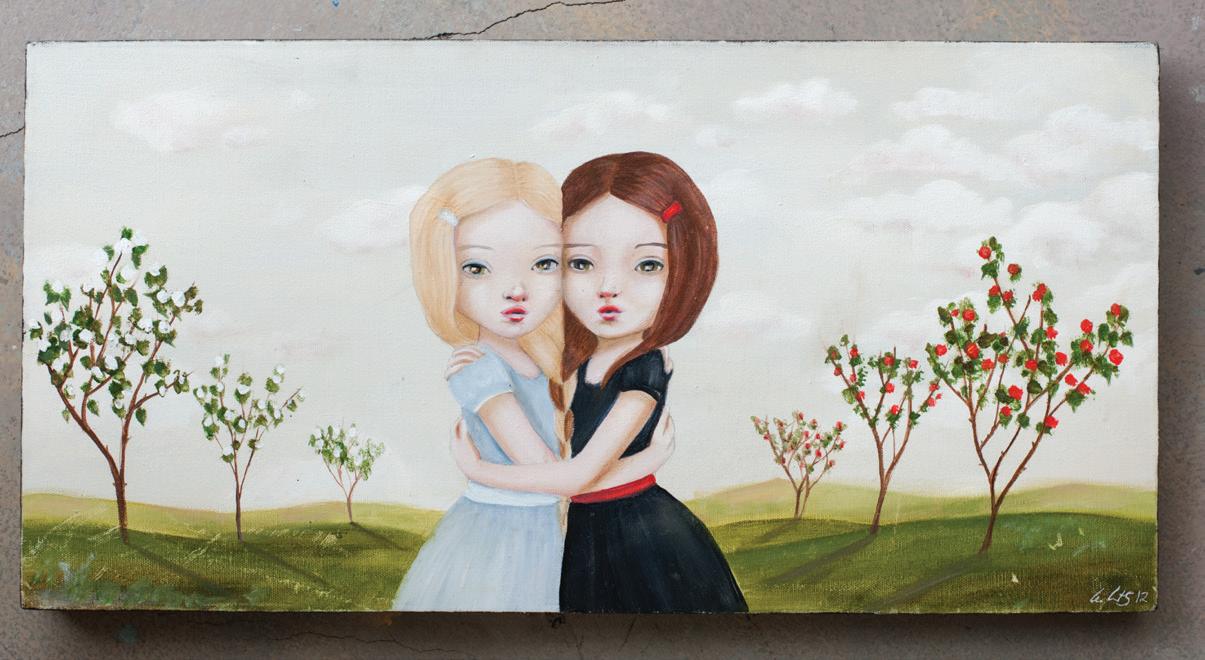
etsy: minoule.etsy.com
instagram: minoule
29
“THERE IS SO MUCH ROOM TO CHANGE AND IMPROVE, ALWAYS, AND IT’S REALLY HARD TO LET GO. YOU FAIL ALL THE TIME, YOU KNOW, BUT YOU IMPROVE. MISTAKES GIVE YOU AN OPPORTUNITY TO REFLECT.”
Snow-White & Rose-Red
MONTEREY HIGHWAY
Written by Mayra Flores de Marcotte
For Silicon Valley, change plays an integral role in the region’s history—and future

It is seen in the remnants of its days as the Valley of the Heart’s Delight: an agricultural playland where innovation spurred growth and growth spurred change. This change led to the creation of technologies that jumped across industries, spurring new ones. The landscape, too, began to morph with these changes—orchards giving way to urban sprawl, and now, to jutting high-rises at the city’s core.
The Valley’s propensity for change, innovation, and growth is what first attracted Marcotte to begin documenting it—first through short stories, then through the lens of his camera. As a youth, Marcotte imagined a booming San Jose through the stories of his WWII-veteran grandfather. This San Jose differed greatly from the desolate San Jose that Marcotte began to discover as an SJSU student. He spent countless hours on foot, exploring his ever-changing community, one block at a time.
Now, Marcotte aims at capturing an important segment of Silicon Valley that is quickly disappearing: the arterial known as Monterey Highway. The haunting beauty of a thoroughfare that was once the main connector between San Jose and the southernmost cities within Santa Clara County is now in a state of purgatory. Sections of local motels, grand neon signage, and empty storefronts have given way to sprawling new housing developments, big-box stores, and more.
The residents who call this stretch of San Jose home reflect the change that is taking place, and Marcotte has worked diligently over the last year, camera in hand, to capture their spirit, their identity through a series of landscapes and portraits, before they too disappear.

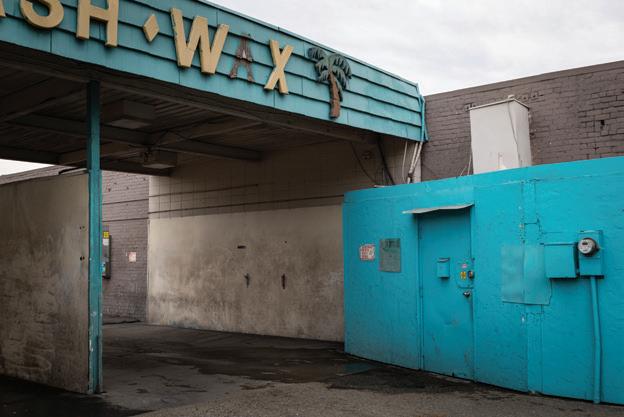

BY JOSH MARCOTTE
PHOTOGRAPHY
Photographs are displayed by location: South First St | Monterey Rd | Morgan Hill | Gilroy this paget. opposite following last
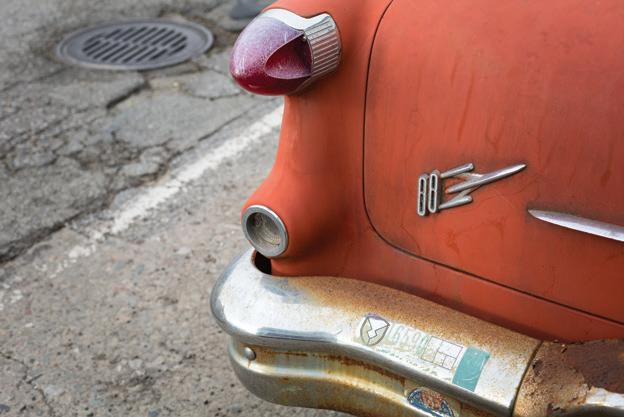






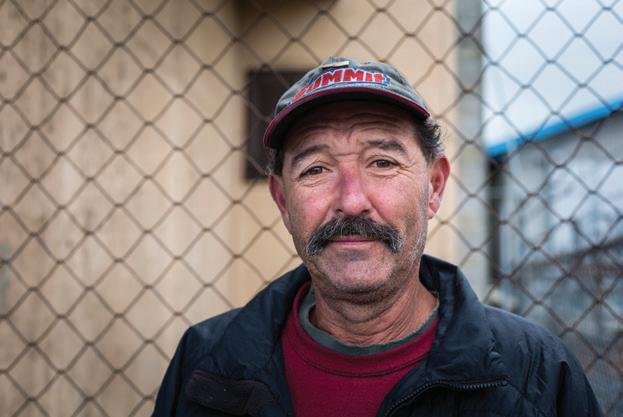

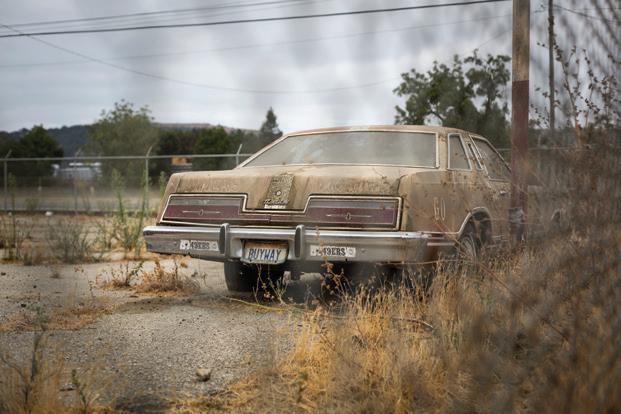
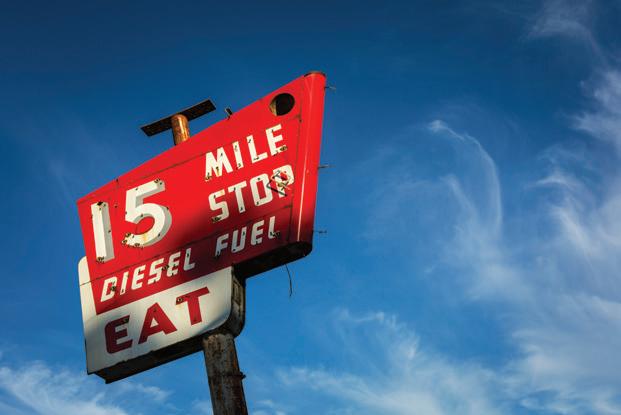



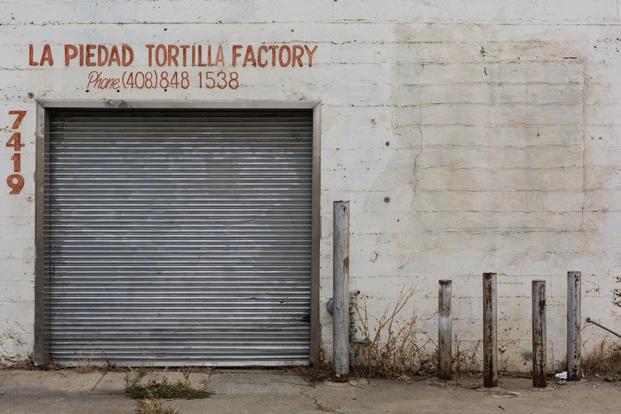

lostsanjose.com View the complete project on March 4, 7–10pm, at Seeing Things Gallery 751 W. San Carlos St San Jose, CA 95126

“TALENT IS NOT THE MOST IMPORTANT INGREDIENT—IT’S PUTTING THE TIME IN, AND PUTTING THE TIME IN NOW.”
Barnaby
Playing a leading role in our film and theatrical scene
It is easily overlooked, the typical concrete university building on San Fernando perpendicular to Fifth Street. But the film and theater department at San Jose State is a mini-production facility—with a custom shop, scene shop, and TV green screens—that gives students the opportunity to write, build, design, direct, and act in class projects, as well as explore their own indie-style features and productions.
At the helm is Barnaby Dallas, who has helped build bridges to the commercial and professional production communities to further provide the South Bay with a growing and quality runway to the film and theater industries.
What is your actual title?
My title, I think my university title, is Director of Theater and Film Production. I coordinate all the film and theater productions—sometimes I directly produce them, but I’m responsible for anything produced in our film and theater department. We have a full theatrical season. And then through Spartan Film Studios, we produce once a year, sometimes twice a year, either a commercial highend short or a feature film. Then we bring in all of the contacts, the industry professionals, to mentor students, to talk to students. We give the best students the ability to be the creative tops. With everything we do, it’s like 60, 65, students on a production, each with some sort of mentor, an industry professional.
How many productions in a year do you oversee?
Four full-blown theatrical productions. We just did The Great Gatsby. It was big. We also did this thing called The Circle, adapted from a Dave Eggers novel. We turned the whole building into, like, a high tech company. It was immersive theater.
And you have a San Jose State Film Festival too. What is that?
I run a student club called the Film Production Society. I’m
their advisor. Because of my relationship with Cinequest, I have a relationship with Camera [Cinemas]. At the end of every semester, the Film Production Society gathers all the best San Jose State films—not just this department, animation is in there too—and we do a film festival.
The films screen at the Camera, with judges. Sometimes I’m a judge, I think Mike Rabehl has been a judge, other people from Cinequest have been judges. But the students actually produce the festival. The cool thing is, they kind of figure out how to do it because most of them intern at Cinequest. So it’s one night, it’s like two hours, and we do it at the Camera 3. Ron Wong, owner of the Cameras, loves the festival. [The theater] splits the money and they give half the box to the club, and then the club uses that money to make movies.
When is the film festival?
We do it the day after finals every semester.
Let’s talk about your relationship with Cinequest. How has that been working, San Jose State and Cinequest?
I got introduced to Cinequest, and we did our first feature film there, a thing called Pizza Wars, that was more of a faculty top-led. I helped write it with another faculty member, Babak Sarrafan [Director of Film and Television Production, SJSU] directed, we used a lot of students, and it played at Cinequest.
Through this, I got to know Halfdan [Hussey] and Kathleen [Powell]. And then the next year, they asked me to help them make a movie, and so I did—with our students— and from that point on I’ve been immersed. I help organize The Day of the Writer. I help students become interns with the festival. We produce content for them. I’ve written and consulted for their studio. I helped on the film they just made, Mr. Invincible, by giving script notes. And about 40 percent of the crew on the film graduated from San Jose State.
35
Interview and Photography by daniel garcia

 Top: Still from The Yellow Wallpaper
Top: Still from The Yellow Wallpaper
36
Bottom: SJSU film students shoot their own project in the basement of Dudley Moorhead Hall over their winter break.
I would say Cinequest has helped make us a legitimate film program because the show rolls into town and our students get to meet people instantly and it gives our program credibility. And I think that we’ve made Cinequest better because of the young, enthusiastic talent. It started out as a bridge, but it’s sort of a symbiotic thing now. We have lots of faculty—Scott Sublett, Babak Sarrafan, Nick Martinez—involved.
Last summer you did a rendition of TheYellowWallpaper, based on the 1892 short story of the same name by Charlotte Perkins Gilman, which will be playing at Cinequest this year. How did that come about?
Kourosh Ahari, one of our best student directors—he did the film Malaise, which went to Cannes—came in with the idea, but he was looking for a writer, even though he’s a pretty good writer. So I hooked him up with Amy Roberts. She’s a great screenwriter, playwright, well…everything. She actually adapted The Circle, the play that we did after filming The Yellow Wallpaper
The two of them got together and they cranked out a 36to 37-page script, and they set it in the ’50s, like Mad Men, right before the feminist movement began. So they upped the time and it worked. It worked because it was productionvalues work. But it also dealt with… they were also able to add in, like, shock therapy and other things that aren’t in the original story but that are cinematically interesting and…
Which modernizes it, but still brings in a scary historical aspect, I imagine?
Exactly. As I would do with Amy, we went into script development. She did some passes and she turned it over to Kourosh. Then we used our [community and professional] relationships to recruit talent, like, literally the best theater actor in the Bay Area, James Carpenter. He’s just an amazing SAG, Equity actor. We were able to bring in people like him to play some of the key roles, which really makes this film strong because, even though he and the others may not be movie stars—most of them are SAG, some of them are our students—the acting is strong. It’s high level.
What can we expect with TheYellowWallpaper?
The setting really makes this adaptation cool. It’s set in a different period, which has those cuckoo nest elements to it. The acting’s superb, but the design—by a student costume designer and a recent graduate production designer—is period-perfect. It’s spectacular and the film’s gorgeous, but when you get inside, when she’s peeling the paper off and seeing whatever she sees in the wall, that’s a set we built here on the stage, and it matches the Rengstorff mansion, where we shot some scenes—if you know the house, it’s gorgeous—perfectly. To me, to have a class be able to design that, to make it period-perfect, is pretty impressive. And they’re young. Usually I’d be worried about doing period things. [laughs]
Because you can have so many inconsistencies somewhere... But then they found the right cars, they found the right trucks, they found the right… And I was surprised at how much the director was able to open it up. I was thinking it’d be a long short, but it’s feature length. And the performances are fantastic. The lead actor, Katherine Celio, she’s one of our best students.
What advice would you give young filmmakers and screenwriters?
Talent is not the most important ingredient—it’s putting the time in, and putting the time in now. Putting the time in and not worrying about it being perfect. Worrying instead about doing, doing, and doing. And doing it the right way, doing it with a positive attitude.
Because when you leave a project, somebody should say, “I’d like to work with that person again,” for your effort, your talent, the whole thing. If you’re going to go in, go all in, or don’t go in, but keep doing it. The only difference between the people, our students, who have made it, who are now working in the industry, and the ones who aren’t, is that the ones who made it are the ones who kept doing it.
See The Yellow Wallpaper at Cinequest 2016, March 1–13. Cinequest.org
SJSU, Department of Television, Radio, Film and Theatre sjsu.edu/trft
“I WOULD SAY CINEQUEST HAS HELPED MAKE US A LEGITIMATE FILM PROGRAM BECAUSE THE SHOW ROLLS INTO TOWN AND OUR STUDENTS GET TO MEET PEOPLE INSTANTLY AND IT GIVES OUR PROGRAM CREDIBILITY. AND I THINK THAT WE’VE MADE CINEQUEST BETTER BECAUSE OF THE YOUNG, ENTHUSIASTIC TALENT.”
37
CORE BUILDERS
A CONSTRUCTIVE VIEW
Every so often a man’s upbringing directly nurtures his career. Chris Neale’s father provided him with the field studies and mentorship he needed. David Neale could see an area’s potential, whether in England, Quebec, or California, and transform it from a fading neighborhood to a vital center for the community.
Chris Neale claimed his heritage, at first by cleaning the office, and later by managing the firm his father started in 1970. Now The Core Companies, a real estate development and construction firm in San Jose, focuses on revitalizing business and residential areas. It works to integrate affordable housing and businesses into walking neighborhoods with accessible transit.
What made San Jose home for you?
The story starts with Dad, who grew up in England. His family owned a business on the ground floor, and lived above it. When I was eight, he relocated our family to San Jose from Montreal because even then, he saw San Jose’s potential.
We moved here when the suburbs were being developed, and malls were in their heyday. Being an urbanist, my dad began renovating Victorians around St. James Park. He built some of downtown’s first ownership projects in the early days of redevelopment. So I attribute everything to his choice to relocate here.
I remember visiting construction sites and working in the office during summers. Through high school and college, I cleaned and painted walls when my dad’s office was on Fountain Alley. Unbeknownst to me then, I helped clean out the space for the San Jose Downtown Association’s new office. We were SJDA’s first landlord. Flash-forward 25 years—I became president of SJDA’s board.
Did you always imagine yourself following in your father’s footsteps?
I always loved what he did, but he advised me to become a Silicon Valley guy. So I got a technical undergrad degree, then an MBA, and landed in real estate. Before Core Companies, I worked for Banana Republic as the West Coast manager for real estate. I enjoyed doing real estate there, but it was just too corporate.
In 1999 I started working for my dad, when he was mostly doing affordable housing. I enjoyed walking the sites with him and seeing people moving into their homes. I vividly remember walking through a project that was nearly finished. He opened the door to show me a unit, and someone was already there—she had just moved in. She was so proud of her new home and invited us in. We sat and heard her whole story.
How did that transition work—from retail development to exclusively housing and mixed-use development?
What developers do isn’t rocket science. It’s about building a team, and knowing enough to ask the right questions, without being an expert. I bring in the architect, engineers, consultants, and contractors. As the developer, I’m the shepherd, the project manager. I gather a team, manage the course of work, hold people accountable, and try to get their best work, by letting them do what they do best. But also by pulling them back if they stray too far. All of which is done within context of budget and schedule.
You mentioned earlier that you were president of the San Jose Downtown Association Board. What does that mean to you?
It was way more fun than I expected. And I got much more out of it than I expected. You work with restaurateurs,
38
Interview by Mark Haney Photography by Daniel Garcia
 Chris Neale, Executive Vice President
Chris Neale, Executive Vice President
property owners, and the different folks who have chosen to locate their businesses here, who are putting their money behind the vision. This level of intimacy is exciting— because you hear about everything that’s new.
The downtown community has been lucky to have such consistent leadership for a long time at SJDA. Blage Zelalich has been here 18 years, Scott Knies for over 25 years, and founding board member Dan Pulcrano has been continually involved. Scott Knies and I have had a lot of really good conversations, and I think he’s enjoyed having a developer for president at this point. He’s alluded that I was the right person at the right time.
You recently took part in an American Leadership Forum. Did that experience change your perspective on work?
ALF put me in a group that allowed me to see myself in a different role. It gave me a space to share dialogue in a peer group of leaders and emerging leaders, and to think about myself outside of myself, which freed me up to behave differently. I began to be comfortable with being uncomfortable, to be okay with falling down because you’re pushing the envelope. Core definitely pushed the envelope this past year. Our high-rise project downtown and our Santa Clara project, which includes an urban farm, are both outside our typical comfort zone. We’re learning as we go. It’s not coincidental that one of our stronger years is tied to the year that I was involved in ALF.
What about the South First Area is important?
We’ve been in SoFA for years, and we’ve always believed in the community. It’s got the funkiness that comes with an arts neighborhood. In a way, developers see through rosecolored glasses. Not as things are, but as they could be—and SoFA has great bones. The neighborhood has evolved since my dad did the Market Gateways Apartments 20 years ago. That project was envisioned as a high-rise, but was negotiated
down to four stories. Now the neighborhood is embracing density, as evidenced by The Pierce, and is visually moving further south to 280.
It’s not just downtown that’s important anymore. It’s St. James, it’s San Pedro Square, the historic area, and SoFA. And SoFA is different. It’s walking distance from transit, and everything north of San Carlos Street, but is still its own neighborhood. So when we proposed our new high-rise, our goal was that the building shouldn’t feel like it could be anywhere—it should feel SoFA-ish. What I love most is there’s energy, the neighborhood has a different vibe.

What does urban exploration look like now, and 10 years from now?
I walk around downtown more. When I go to City Hall, I try to walk a different way every time. Six years ago, if you walked the same route several months apart, it wouldn’t have changed much. What’s so fun the last year or two is all the new stuff going on.
In the next 10 years, I think some dots are going to start connecting. The neighborhoods will gain their own identities, and will start connecting to each other, making walking between them more interesting. Diridon Station will broaden downtown, due to the city’s preplanning work to create space supportive for investment. It could become like what Mission Bay is to San Francisco, where the freeway separates them. Here, people will migrate back and forth more seamlessly.
Is there anything else you want to add?
The theme of looking at the past, as we look to the future. We are not the first group or generation who has seen the city’s potential, and we’ve fought hard to get it there. A lot of groundwork has been laid that we’re benefiting from. Once downtown reaches its critical mass, it will have its own existence and be able to stand on its own.
40

41 thecorecompanies.com
“In a way, developers see things through rosecolored glasses. Not as things are, but as they could be—and SoFA has great bones.”
_Chris Neale
HEROES COMIC BOOKS
If you live in the South Bay, chances are you’re aware of Heroes Comics, even if you’ve never read a comic book in your life. The shop has been open since 1985 and in its current location since 1990, and its sign—“HEROES” in black block letters accentuated by an “O” that resembles Captain America’s shield—dominates the East Campbell Avenue and Winchester Boulevard intersection. You might say it’s the unofficial gateway to downtown Campbell.
But take a closer look. Step over the threshold for the first time and be transported to a lush collector’s paradise of trading cards, action figures, graphic novels, and vintage comics. Original art adorns the walls while posters cover nearly every inch of ceiling. If you’re looking for an out-ofprint release or a rare alternate cover, chances are it’s here, lovingly tucked away on an overstuffed shelf.
After you speak with Alan Bahr, the shop’s owner for over a decade, it becomes clear that while the shop may be a business, its walls are an outgrowth and celebration of his own love for comic collecting. The decor seems to substantiate his belief that comic dealers aren’t a lot different than the collectors they sell to.
Though he’s lived in the Bay Area since 1985, Alan is native to Bagley, Minnesota. Bagley is a small town, and in his early years, Alan recalls picking up comics from the small selections of the only two local drugstores that sold them. Reading DC titles like Batman and Superman as a young child led to Marvel’s X-Men and Avengers issues in his early teens. But he fell out of collecting a few years later, gravitating toward cars and girls until he picked up the hobby again in college.
“I don’t think [collecting comics] was something that you were ashamed of in those days, but it wasn’t something that you would broadcast,” he recalls. “Now it really is much more mainstream and acceptable than it ever was.”
Settling in California came as a result of knowing the right people at the right time. A friend had moved to the Bay Area for a tech job and needed a roommate. Alan was fresh out of college and welcomed the offer to relocate, ending up in sales positions at Cyprus for more than a decade. When he had the chance to purchase the Heroes shop in 1995, he jumped at it. “It seemed like an opportunity that would be fun to try,” he says. He’s never looked back, and he’s still drawn in every day by the mystery of what might be in someone else’s collection.
As both a fan and a vendor, he particularly treasures original art pieces because each one is unique. And he still picks up World War II–era comics for his own collection whenever he can, even though nowadays his personal interests are largely satisfied by the shop’s inventory.
“When you’re a collector, every day to some degree is a treasure hunt, whether you go to a shop on your lunch break or go to a flea market when you’re in town,” he notes. “You never know what you’re going to find in that box. The greatest thing about owning the shop is all the stuff that walks in. It gets me up and going every day.”
It’s obvious that Alan values the rapport he’s been able to establish with his clientele. He says that 80 percent of his customers return weekly to check new inventory, and some have been popping in for over 20 years. When asked why comic books in particular seem to elicit such a passionate response from fans, he smiles and says, “Comics have a magical quality. For some people, when they hold an old comic book, it makes them feel like a 10-year-old again.”
Inside the cramped walls of the Winchester shop, customers get to experience the “a-ha moments” for which collectors live. Heroes Comics allows Alan to give back to the culture he fell in love with when he first picked up a Batman release in the back of a Bagley drugstore all those years ago.
42
Written by brandon Roos Photography by daniel garcia
heroescomicbooks.com 24 E Campbell Ave Campbell, CA 95008 408.378.3667
TWENTY YEARS SINCE PURCHASING HEROES, ALAN BAHR STILL ANXIOUSLY WAITS TO SEE WHAT GOODIES WILL WALK THROUGH HIS DOORS.




43
ASHLEY HILL
A 2,600-MILE PERSONAL JOURNEY ALONG THE PACIFIC CREST TRAIL
Soon after the one-year anniversary of her mother’s passing and with very little backpacking experience, Ashley Hill set off on a five-month-long adventure to hike the Pacific Crest Trail. “You can’t imagine walking 30 miles a day, camping out by yourself, making your meal by yourself, watching the sunrise, sunset—every single day,” Hill says. “It was the best decision I’ve ever made in my life.”
How were your feet when it first started hurting?
My first pair of shoes lasted me 500 miles. Most people go through four or five pairs of shoes for the whole trek. I didn’t realize it wasn’t normal to have bruised soles. It was the most painful experience, because you can barely walk. I had bought a second pair and I wore those for almost the rest of the trip. Then I was like, “I miss my old pair.” I decided to finish it in my old pair, which was a bad idea. It hurt, but it was special.
What is the terrain? Is there actually a path?
Absolutely. It’s about like an 18-inch wide path, to extreme wilderness and mountains, and there are a few river fords. They weren’t so bad.
With snow hiking, I started with an ice axe. It saved my life. I definitely fell. I think it was day two. I had no snow experience.
How far did you fall?
I slid down, so I had to self-arrest, with the ice axe coming
in and saving me about three feet before the snow stopped. If you can imagine this snowfall and then it goes straight down a cliff...
The snow stops and after that it’s just a direct fall? Yeah.
How far down? To death? Yeah, to death.
Did you think that you were going to die?
Yes. I said my last words. I said goodbye, made peace with it. Now, here’s the worst part, I had to go up to Canada to touch the border, and I knew I had to come back. I was ready to go around the base, detour 20 miles more just to not do that part again because I was terrified.
In general, though, did you feel safe on the trail?
Always felt safe. The most common question that people ask me is about the crazy people, and they don’t exist. There are no crazies out there. The thing that you have to be more fearful of is the weather. Weather, if you get sick, if you fall or injure yourself.
So now you’re mentoring other hikers...
You become part of this hiking community and all you want to do is share the knowledge and the wealth. I’ve met up with at least seven people who plan to do this. You would
44
Intervew and Portrait Photography by Daniel Garcia All images provided by Ashley Hill
The Pacific Crest Trail is 2,663 miles along the Sierra Nevada and Cascade mountain ranges from the US-Canada border to the US-Mexico Border. Currently, Ashley is trekking New Zealand’s Te Araroa Trail, a 1,864-mile route stretching from Cape Reinga in the north to Bluff in the south.

“ONE THING ABOUT THE HIKE FOR ME, WHAT IT BROUGHT OUT IS JUST BEING POSITIVE TO EVERYBODY.”




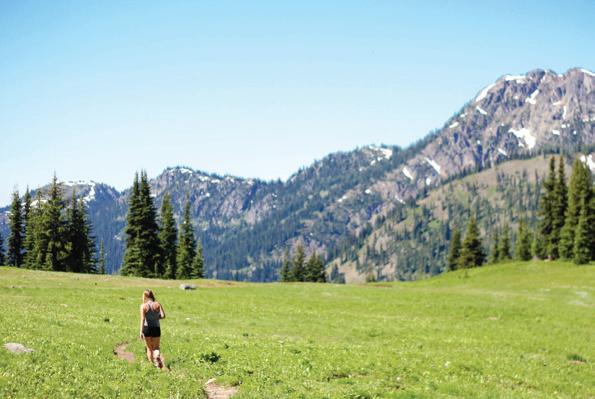



never know if you haven’t done something like this because it is a completely different ball game than camping. You try to get your backpack down to under 10 pounds. Ten pounds of base weight with no food or water. I was cutting off straps from my pack.
Just to lose an extra ounce.
To lose an ounce, yeah. You think, oh come on. You cut off edges of your maps. Each thing adds up. Your toothbrushes cut in half—this is what you do. All of that adds up to three pounds, four pounds.
What advice would you give someone after your experiences?
Dream big. Once you get the idea in your head, it might take two months to work toward making that happen. It might take two years. It doesn’t matter. You can do it and make it happen. And start telling people too, because once you tell people, it’s really hard to back down, because you feel shame. [Laughs.] It’s like, just start telling people, then I can’t say no, even if I’m scared.
Just out of curiosity, have you seen the movie [about the Pacific Crest Trail] with Reese Witherspoon?
Everywhere I went, when I came into town, they’re like, “Oh, you’re just like that Cheryl Strayed girl from Wild.” Especially because she and I have a similar story. She lost her mother, she was young and divorced. I didn’t have the sex and drug addictions like she had, but there were some parallels with her story and mine.
One thing about the hike for me, what it brought out is just being positive to everybody, [regardless of] their level. [The movie] motivated a bunch of people to go out and do this, and that’s something I can say is very positive. It also diluted some of the trail, not the authenticity, but more the wildness. [Before], the people who were doing it were more experienced, because you can’t go out into some of this stuff without being prepared. It’s dangerous stuff. There were several people who died on the trail just from not being prepared. So you have to take things seriously.
But if [the movie] motivates somebody and changes their life, that’s wonderful.
sobohobo.com
instagram: ma.vie.en.rouge

47
ADOBE Chuck Geschke

48
FOUNDERS John Warnock
 Interview and Photography by Daniel Garcia
Interview and Photography by Daniel Garcia
John Warnock and Chuck Geschke met at Xerox’s Palo Alto Research Center (Xerox PARC) in the late ’70s but left to form Adobe when they could not convince Xerox executives of the potential market value in developing a printing language that would generate quality fonts and graphics on any printer. The decision to launch their own company has led the revolutionary direction of computer graphics and shaped the publishing and creative communications industries. The influence and effect that these two humble computer engineers and scientists have had is a testimony to their vision, character, and partnership.
Your first day with Adobe, what was that like?
John Warnock: We didn’t have an office, the first day we started Adobe. We worked out of our houses for a while. We had a computer that we could dial into, and so we started that way.
Chuck Geschke: You know, it’s interesting, there we were, the two of us in this building. You sort of felt like you should shout down the hall, “So, you still there?” Then we began to hire people, so within a couple of months, it at least felt like we were a team of people engaged in working on what was our initial business plan and idea, which of course changed within our very first year in business.
What was the original plan?
CG: The original idea that got us our funding was to build a complete turnkey publishing system for marketing inside the Fortune 500, so they could bring a lot of their creative work and their print production in-house.
We were going to build and bring together computers, laser printers, and plate-making equipment, along with all of the software to go into complete production. One of the key ingredients of that was our technology called PostScript, which is a higher level language for describing the appearance of a printed page.
JW: At that time there weren’t PCs broadly available. The workstations at the time were made by Sun Microsystems and Digital Equipment. Those workstations were what people developed software for. The PCs were really very small, just starting to come out, so they weren’t a factor. There were companies like TechSAT and Interleaf that were also building publishing software. There were about five or six competitive companies in the space that we thought we were going into.
CG: So shortly after we got into business, one of my professors from Carnegie Mellon who had since left and gone to work for Digital Equipment, Gordon Bell, came by to see what we were doing.
He looked at it, and he said, “Wow that’s interesting. But I don’t need computers, I’m Digital Equipment. And I got a deal with Ricoh in Japan for this laser printer, so I don’t need that, but my problem is they’ve got two or three development teams trying to figure out how to get the computers to talk to the printers in such a way that they can produce the kind of output we want, and they’re not getting anywhere. I see you’re starting to work on the key software that would make that possible. Why don’t you just sell me that software?”
We said, “Well, you know we have this business plan, and it raised two and a half million dollars for us, and we think that’s
what we need to do, so we’re going to continue doing it.” He said, “Well if you change your mind, call me.”
JW: About four months in, we got a call from Steve Jobs. Steve had been hiring people away from Xerox PARC, and they were people that we both knew. He said, “I would love to come see you guys and see what you’re doing.”
At that time, that was the beginning of the development of the Mac. First the Lisa was developed, and then the Macintosh. But at that stage he was mostly interested in the Macintosh platform. His problem was, what they could see on the little bitmap screen they could print on a wire-matrix printer—which was horrible. I think he sensed that that was not an ultimate printing solution.
He saw what we were doing, and the people who worked for him knew what we were doing, and so he became very enthusiastic about this software we were developing, which was PostScript.
CG: The first thing he said was, “Why don’t you sell me your company, and come work for me?” We said, “Well, you know, Steve, we really want to build our own business.” He said, “Oh, well, OK, I can understand that. So, how about selling me that software? Because the team I have trying to figure out how to get the computer, the Macintosh, to talk to this laser printer, which I’ve already got a deal for with Canon, aren’t getting anywhere.”
And we said, “Well, you know we have this business plan, Steve. That’s what we think we need to do.” He said, “Well, I think you’re nuts.” So then John and I went to talk to the guy who was chairman of our board, that Bill Hamburg had put in as chairman. We explained to him these conversations we were having. And he said, “Those people are right, you’re nuts. Now you know what your business plan is, go do it.”
When you began Adobe, were you already thinking in terms of adjusting based on market need? Is adapting just part of your personalities?
JW: I think we were flexible. Both of us had a very deep background in technology. What you’re trying to look for is markets and customers. Steve wanted to invest in the company, which he did. The strongest part of our software was the PostScript software. We would have had to develop the rest of the software from scratch, and that was going to take a lot of time and a lot of effort, and since we had ready customers both in Digital Equipment and in Apple, I think that’s what guided us in the direction we went.
CG: You do ask a good question though, “Did we originally think about the fact that we should be building something that was
50
unique and different?” Of course, that’s instinctive to want to do that, but when we got the first check from Bill Hamburg and we were driving home from San Francisco, I asked John, I said, “John, did you ever take a business course?” And he said, “No.” And I said, “Well I haven’t either.”
So we looked at each other and I said, “I think we should stop at Kepler’s and get a book on business.” We did, and there was a chapter in that book called “market gap analysis.”
What it said was, if you want to start a successful business, find a place that isn’t being served, come up with a brand new solution, get it into the market, and by definition you have a hundred percent market share, and shame on you if you can’t keep it. That’s actually pretty much always been our philosophy.
JW: PostScript became a very successful product. It became the standard, and it was saturating the company’s resources, to just keep up with the number of corporations we had to build printer software for. But it was also obvious that you never want to be a one-product company. And so we first started with typefaces for the PostScript printers, but we had worked with drawing
programs at Xerox PARC, and thought there was a natural way to map the way that PostScript fundamentally worked with a user interface, and that became Illustrator.

You’ve been in partnership for...?
CG: 37 years.
Thirty-seven, which is longer than some marriages.
JW: Probably most.
CG: Except ours.
JW: Chuck and I have a huge amount in common. We have the same number of children, roughly the same ages, roughly the same educational backgrounds in mathematics and in engineering. We both refereed and coached soccer. We’ve been married roughly the same number of years to our wives. We’ve never had an argument, in the 37 years.
Never?
JW: Never.
51
I’ve always told our employees who want to rise in management, just go out and hire people who are incredibly smart. Smarter than you are, it’s a bigger population from which to choose.
CG: Never parted company at the end of a work day in anger.
JW: I think our personalities mesh very well. We both have a sense of responsibility to the communities, to the customers, to our stockholders, to our employees. We take very, very seriously the balance that we have for the constituencies of the company. And I think we both work—with each other and with others—as teams. I don’t think we’re dictatorial in any way. I don’t think we try to micromanage people.

John, how has Chuck balanced out your skill set?
JW: I think we’re great sounding boards for each other, and are both technically very competent. What more do you need? [laughs]
Chuck, what about John? How do you think he has balanced out your skill set?
CG: I think the uniqueness of John is built around his inventiveness, and thinking of things that other people have not thought of before, in terms of what can be done with technology.
I’ve always greatly admired that skill.
I think in terms of implementing ideas, we’re very comparable in that regard. I ended up doing a lot more of the negotiating and contract work, particularly in the beginning with PostScript to close deals all over the world that would allow us to make that a universal standard.
John, on the other hand, was the person who really kept focus on what the company needed to do to continue to expand its markets. The thing I found most comforting about our partnership was whenever we needed to do something outside of business—deal with something in our family, or just take a break—we had a hundred percent confidence that the other person would do and make the right decisions. That gave us great freedom. It allowed us to explore and to do things that wouldn’t have been possible if we hadn’t had that confidence in each other.
When you acquired Photoshop, there wasn’t any digital photography [laughs]. You had to see into the future of
52
You don’t have to be ruthless to be a successful business person. You can be understanding, you can be compassionate, you can have all those qualities that make you a good person.
technology. Even with the cloud, you were one of the first companies to move all your software exclusively to be a download. What led you to innovate?
JW: There was no such thing as illustration programs. There were programs back at Xerox PARC that started to do that kind of thing, but they were never commercially available.
I think, as Chuck said, you’re looking for gaps. You’re looking for problems that have no solution. It was so funny, when we went out on one of our first road trips, the investors said, “Well, how big is the market?” We were puzzled by that, because there was no market. We were in fact creating the technology to create a whole brand new market, and they didn’t understand that and we didn’t understand their question. It was sort of a humorous thing to think about ideas and uses of technology where you’re entering a completely void space.
CG: I think the thing that never concerned us about how big this opportunity was, what we were beginning to understand was, that all visual information was going to transform itself from physical media and distribution to electronic.
If you look at the size of that industry—printing, publishing, entertainment, the whole paper flow business—those are huge. We never felt like we would be constrained by the market opportunity, only by our own ability to invent fast enough to be the first product into that market so that we in fact could have significant market share from the very beginning.
How would you describe yourselves? What are your natural passions?
CG: When I think about myself, first of all, as I already mentioned, no formal training in aspects of business. Throughout my life I’ve been a teacher, I’ve been an engineer, developing things, and I’ve always worked with teams of people.
I think one of my strengths is that I understand what makes a team work. I instinctively believe in people and their ability to do more than they think they can. I really have no fear, never had any fear, of hiring someone who is brighter than I am. I hired him [pointing to John] at Xerox PARC, and I’ve always told our employees who want to rise in management, just go out and hire people who are incredibly smart. Smarter than you are, it’s a bigger population from which to choose. If you do that, eventually there will be nothing for you to do but move up the ladder of the chain of management.
John and I decided early on that we were not going to write elaborate manuals of behavior of what it meant to be an employee at Adobe… The trick is to balance what’s good for each of [your constituencies] in such a way that everyone feels like they’re being well-served. The core principle is you always treat any of those people, including your fellow employees, the way you would want to be treated. And if you do that, you’ll succeed.
JW: In my hobbies, I’m a photographer. I do a lot of drawing and painting, I’m primarily a visual person. It’s funny, it’s a funny balance between mathematics and that visual left-brain / right-brain connection.
The internet today is the perfect communication vehicle, when you want to know something. All my children and grandchildren, they pick up their phones and do the appropriate search, and find out the answer to almost any question you’d
want to ask. I think that in some sense amplifies the progress of the society in what you can achieve. In the past, you had to really do research in libraries and go the hard way to find out information. Now information is flowing very freely. And building the tools that allow that to happen, that allow people to communicate in a frictionless way, is what it’s all about.
What would you say, then, is your guiding philosophy?
JW: I think it’s exactly what Chuck said, you treat people the way you would like to be treated. You don’t have to be ruthless to be a successful business person. You can be understanding, you can be compassionate, you can have all those qualities that make you a good person.
CG: I think oftentimes people view two guys who go into business and have the good fortune that we did to be very successful as—they did it for money. But we’re both engineers, and what motivates an engineer is to build something that millions of people will use. We achieved that dream.
JW: It’s not money.
CG: And the money is wonderful, you know, I wouldn’t throw it away. But frankly, I would prefer to take that money and do more things to help other people than use it myself.
What drives your passion, outside of business?
CG: The things that I tend to focus on, are really my family. We’re blessed with seven grandchildren, all the way from second grade to college. Spending time and working with them is part of my passion.
My wife and I have always loved travel, we’ve had a long bucket list of places we wanted to go, many of which we’ve already been to, but we still have some more. We’re going to the Arctic. We’re going to take the whole family on safari next summer. Things of that kind are passions of mine.
[And then the other thing] is to focus on some nonprofits that really make a difference in their community. I just finished a project with a good friend of mine on Nantucket Island, rebuilding the entire Boys & Girls Club, because it’s so critical to the survival of that island. It’s things like that that I spend most of my time on.
Of course, I do think a lot about Adobe, and its business, and where it’s headed, but over time I’ve diversified.
JW: I’ve always been fascinated with the media business. I’m on the board of Sundance. I’m chairman of an online magazine called Salon. I was on the Knight-Ridder board in the newspaper business. I love tracking the media business.
As you see the growth of the internet, and the transitioning out of old media into new media, you see a huge shift in the dynamics of advertising, communication, and how all of that works. Watching the way television and streaming media is changing people’s fundamental behavior, I find fascinating. I’m a student, when I think professionally, of media, and how it works, and how it’s changing. I think the most important thing is how it’s changing, and what the implications are of that to everybody’s life.
Is there anything else you would like to share?
JW: It’s been a hell of a run. [laughs]
CG: We’re the two luckiest guys on Earth. Adobe.com social media: adobe
53
INSIDE ADOBE
We see the tower, with its semaphore circles spinning their tale. We use the products daily for work or play. Yet, the building can seem like a force. People flood in and out, doing their mysterious work behind the gray marble wall. Many of us have friends or family members who work at Adobe, granting us a connection to one of the world’s most influential companies, endearing us further to the brand.
John Warnock and Chuck Geschke have built an empire of creative software, knowing that the need to innovate was the only way to serve and grow. At the core of Adobe are its people: from the founders who encourage innovation to the team members who create the tools for our digital publishing, marketing, and creative needs.
Here is a look at a cross section of the people who help carry the torch that Geschke and Warnock first lit when they started Adobe from their homes in 1982.
adobe.com social media adobe Photographed at the Adobe Systems CORPORATE headquarters, San Jose 54
Photography by Daniel Garcia
As a designer, artist, and programmer, I find great joy in giving material substance to ideas through immaterial areas, like computer code.
As a Principal Artist-in-Residence for Adobe’s CTL (Creative Technologies Lab) Research group, I have the great fortune of working on a variety of products and initiatives throughout the organization. I spend the majority of my time
 Erik Natzke Principal Artist-in-Residence
Erik Natzke Principal Artist-in-Residence
collaborating with researchers and trying to anticipate where the future of creativity is heading. With the perspective of artist and creative professional, along with a rudimentary (and stubborn) drive to wield code into viable product creations, I strive to discover uncharted territories and inform the technological pursuits of our organization. A bit of a scout mentality. Having worked a long time outside of
Adobe (relying heavily on their tools to execute my ideas), I’m driven to find ways to reduce the friction within the creative process. I empathize with the existing spectrum of creative professionals, as well as those who don’t quite consider themselves a “creative” (yet). In the cult of creativity, ideas only gain value when they’ve been realized. Tools are the bridge between thought and reality.
55
As a principal scientist, I develop technology that allows our products to use natural language to converse with our customers so that they can enjoy a more engaging search experience.
Before I joined Adobe, I developed extensible relational database indexing systems at the IBM Almaden Research Center. Later, when I was at Oracle, I built both application tools and asymmetric database replication software. Most recently, as a managing director at Scient, I led the team that designed and built the real-time game-day visualizations, data feeds, video capture, and streaming audio functions that all of Major League Baseball uses.
At Adobe we’re exploring ways to understand free-form text using natural
Walter Chang Principal Scientist
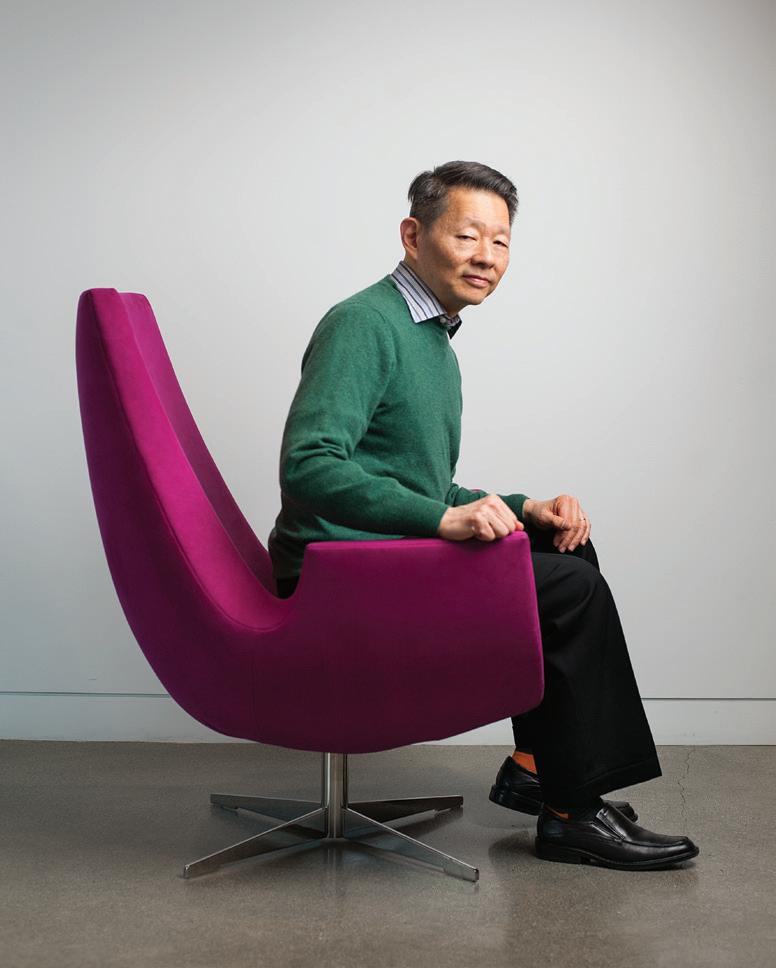
language processing and computational linguistics. In collaboration with other researchers, I‘ve developed an automatic system for understanding and tagging Hollywood movie scripts for Adobe Story. More recently, we’ve built conversational dialog systems such as PixelTone, a digital assistant that allows users to edit images by natural language and gesture, and a system called DataTone, which helps business users easily explore and retrieve their analytics data.
I’m grateful for the opportunity to work with some truly amazing researchers, engineers, and product architects—I find it rare for a work culture to combine forward-thinking research, the diverse and deep expertise of its technologists, and keen attention to design aesthetics and
the artistic elements needed for creating engaging user experiences. I continue to be excited by finding all of these at Adobe Research.
I like the 1971 quote by Alan Kay that “the best way of predicting the future is to invent it.” I’m also inspired by another quote by the semiconductor manufacturing innovator Morris Chang, who said: “To innovate, you need both learning and critical thinking: just learning causes you to become lost, just thinking is limiting by not having enough good ideas.” I have found that Adobe Research provides an environment to learn, critically think, interact, and innovate while combining a design and art aesthetic to create technologies that can positively impact and improve people’s lives.
56
I lead initiatives at Adobe Research that accelerate innovation, stimulate new technology explorations, and protect and promote our inventions.
As an award-winning child-artistturned-scientist with innate organizational skills (I have both a PhD in theoretical physical chemistry and a master’s certificate in project management), I bring diverse interests and skills to my role.

My interests also drove my involvement with diversity initiatives at Adobe. I love volunteering as a mentor for Girls Who
Sara Perkovic Director
Code, have enjoyed co-hosting a Creating the Life You Want event for Adobe women, and I’m inspired by the impact of the Adobe Women in Technology event that I organized and hosted. One of my proudest achievements is co-founding the partnership between Adobe and The National GEM Consortium, which supports underrepresented women and men pursuing their graduate degrees in computer science.
I am also proud of developing and launching the University Relations
program supporting an open innovation culture at Adobe Research. And I’ve had a great time launching a new approach for communication that uses multimedia storytelling.
Over the years, I have done my most creative, innovative, and impactful work when I imagined a better future, had the courage to take the first step, and persevered in my endeavors. When I found myself in front of a locked door, I chose to build a window.
57
Dan Cowles Creative Director
I’m the Creative Director for Video for Adobe Studio, and my team and I create most of the video—both public facing and internal—for Adobe’s creative products. Being a creative filmmaker within a tech company isn’t the same as working in Hollywood, where you specialize and can work on one project for a long time. For us it’s different: we produce an incredibly broad range of content—from traditional corporate to straight-up documentary work to beautiful motion graphics pieces, studio shoots, events and social stunts, even comedy.
Our small team produces a lot of volume. Innovation means something different in this environment. It’s still about finding fresh and creative solutions
to old problems, but so much of the work we do is communication, and planning, and navigating complex corporate environments. It really requires a breadth of skills. The ability to do high-quality, leading-edge, and effective work on tight budgets and short timelines, all while maintaining a consistent brand voice— well, that’s pretty much the job description right there.
The Bay Area is a really creative place, and Silicon Valley is obviously ground zero for tech innovation. I’ve worked in tech myself for over twenty years, originally as a data analyst working with big data and data visualization (before those were buzzwords), and have been doing “internet video” since the early days of multimedia. I

love the smart, innovative spirit in the Bay Area, and you can’t help but be inspired and motivated by it. But I also came from a filmmaking background, and grew up on film in the time of the art house. I think munging that cinematic sensibility and passion with the tech culture of innovation and disruption is what’s helped us elevate the work, and is probably the closest thing we’ve got to a secret sauce.
It’s tough out there for Bay Area filmmakers these days. I’ve managed to find a little niche here where I can be creative and work in the medium I love. I forget sometimes, but I’m pretty lucky to have landed in this spot at Adobe, where creativity and quirkiness is appreciated and encouraged.
58
When I was young, I liked to draw. Growing up in South Korea, I never imagined I would move to the US and work for Adobe Systems. I learned how to use Photoshop and After Effects in college, and I knew that I wanted to work in computer graphics.

When the internship opportunity with Adobe arose, it was a dream come true.
I spent the first part of it working with my mentor on the Photoshop Fix face liquifying features. Now, we’re working
Gahye Park Tech Intern
together on some advanced paint features. Drawing and programming are both creative activities, and when I first started to write code, I was frustrated by my own limitations as a developer. But as my knowledge grew, I realized that what I can create using code goes far beyond what I could have ever produced on a real canvas.
For me, inspiration comes in many forms. I’m curious by nature, and come up with great ideas from watching the news or videos about some new innovation. My
office is located on the laboratory floor, so every day I’m inspired by the interesting work my fellow interns are doing. Good ideas generate more good ideas. Sometimes when I’m stuck on a difficult problem, I step away from the computer and either sketch or write notes to help define the problem, thinking through the constraints and limitations. Eventually, a workable solution comes to me.
I’ve learned much in the past eleven months. Overall, it’s been a great experience.
59

ROOTS AND RYE
BRINGING “THE GOOD STUFF”
Roots and Rye is not a subtle place. The heavy bar stretches the length of the main room, and the low-slung leather sofas in the lounge area are positioned around rough wooden tables that look like they’ve spent a lifetime holding up glasses of bourbon. Fire glows from the sleek, modern fire pits on the terrace, and rows of tables, some with cold marble tops, align the main dining area. The whole place is framed with raw pine two-by-fours that make it look like the belly of an old wooden ship, a rustic hunting cabin, or perhaps a project the contractor never quite finished. All of this heavy, wooden, masculine decor seems to scream, “This is a serious place for serious drinking!”
Fortunately for San Joseans, Roots and Rye does take its drinking seriously. In what could have been a whiskey theme park for weekend Jack and Coke consumers, Chris Yeo, the man behind the popular restaurants Sino and Straits, created a whiskey bar for whiskey lovers. Located in Santana Row, Roots and Rye boasts a liquor menu that is seven pages long and offers some of the finest names in tequila, rum, brandy, vodka, and gin. But then there’s the whiskey: from Irish, Scotch, and Japanese varieties to bourbons and ryes. The collection of beautiful and rare liquor bottles lined up behind the bar will make any connoisseur feel giddy and any amateur feel adventurous. And therein lies the strength of the menu—it’s approachable, affordable, and fun.
For those looking for renowned Pappy Van Winkle bourbon, you won’t find it—at least not yet. Roots and Rye won’t serve their stash until they’ve created the perfect whiskey flight to complement it. They’ve had to work hard to earn the trust and respect of micro and elite distilleries around the world. Producers of “the good stuff” want to make sure that their product is on the shelf next to other rare and highly prized bottles. This means that the team at Roots and Rye is building relationships from Kentucky to Kyoto and that they are committed to carefully curating an unparalleled list of spirits.
In the meantime, Roots and Rye is continuing to create and improve upon craft cocktails. They seek out and hire
bartenders with craft cocktail experience and take pride in their handmade syrups; unusual, fresh, local ingredients; and signature recipes. Each cocktail takes time to make and must follow a scripted order of mixology. Silicon Valley scions used to instant gratification might find it hard to wait for each individual liquid masterpiece, but the salted watermelon syrup, chrysanthemum honey, and pickle-spiced-infused dry vermouth are worth it. With names like Triple Crown, Grandstand, and Seersucker, Roots and Rye’s cocktails pay homage to Kentuckians and their second favorite pastime behind distilling—horseracing.
The servers are just hipster enough, many wearing suspenders and pork-pie hats and all knowing the difference between the WhistlePig Boss-Hog Rye and the High West Double Rye. They can help you navigate between Buffalo Trace, Cyrus Noble, Johnny Drum, Rowan’s Creek, Michter’s, or Willett Pot Still Reserve bourbons. The whole team, from bartender to busser, seems equally dedicated to the mission of good liquor. They won’t upsell you or patronize you. They are docents, there to guide you toward just the drink you didn’t know you needed.
Chef Kat Hu has whipped up a menu that doesn’t play second fiddle to the spirits, but rather complements them. The small bites might be small, but they are rich in flavor with luxurious ingredients. Hu tempts customers with oysters, mussels, squid, artisan cheeses, pork belly, foie gras, the R&R burger, and even roasted bone marrow. The big bites are hearty Petaluma chicken, a pork chop, or beef short ribs. Hu makes dishes personal with her housemade additions: cucumber kimchi, pickles, and applesauce. It’s a bold menu that she is still fine-tuning, one with a modern twist that offers diners a chance to be a bit daring or to be comforted by the classics.
Happily for San Jose, Roots and Rye has officially arrived and has a place among the city’s most creative and exciting atmospheres. While it is still tweaking, expanding, and figuring itself out, it will be a pleasure to go along for the ride, perfect single malt in hand.
61
Written by Kate Evans Photography by Daniel GArcia
THE TEAM AT ROOTS AND RYE IS BUILDING RELATIONSHIPS FROM KENTUCKY TO KYOTO. THEY ARE COMMITTED TO CAREFULLY CURATING AN UNPARALLELED LIST OF SPIRITS.


62
Julian Yeo Chris Yeo
rootsandrye.com


instagram: rootsandrye

63
14 Oz bone-in pork chop kohlrabi gel, butternut squash, and pomegranate seeds with a chartreuse pork jus.
Deviled eggs bacon bread and pickled radishes.
Crispy Pork terrine agedashi tofu, pickled mushrooms, pink ginger gel.
 Stephen Shelton
Philippe Breneman
Jimmy Marino
Stephen Shelton
Philippe Breneman
Jimmy Marino
64
Don Durante
BLACK SHEEP BRASSERIE
The lineage of Black Sheep Brasserie would be the envy of any fine restaurant. Partners Don Durante (of Cascal in Mountain View), Stephen Shelton, Jimmy Marino, and Philippe Breneman (the latter three of The Lexington House in Los Gatos) have vast and varied experience in a tough industry, and their expertise shows in every flawless corner of their new venture: from the feel of the place—with its rough-hewn walls, wide-beamed wood ceiling, and splashes of bold red accent—to its lush cocktails, carefully curated beers and wines, and artisanal menu. With Executive Chef Jeff Fitzgerald (formerly of Dio Deka in Los Gatos) supervising the kitchen, Black Sheep Brasserie is a dining experience not to be missed.
Co-owner Jimmy Marino fills in a little of what it’s been like for these four partners to pull this new venture together.
Tell us about Black Sheep Brasserie.
So, BSB is our second restaurant endeavor. The three of us who started The Lexington House in downtown Los Gatos always had ambitions of doing more than just one place. We were fortunate enough to find this little spot in Los Gatos and to open something of our own. I will be honest, Black Sheep Brasserie was a little sooner, a little bigger, than we had envisioned for our second project, but the location, the space, and with Don Durante on the phone wanting to partner with us—he is a restaurateur with a great pedigree—we would have been stupid to say no… So, the four of us teamed up to bring a new spot not only to San Jose, but to the whole South Bay. We wanted our style and sense of place to shine, and our service touch to be accessible to more people. The Lex is small, and Don’s other restaurant, Cascal in Mountain View, is not necessarily close to San Jose. We saw BSB as being a great way to showcase what we all could do. We were all on the same page about doing a modern French brasserie guided by our abundant Northern California bounty. With so much amazing produce and ingredients available right in our own
backyard, and with the French brasserie as the backbone, it just felt like the perfect fit. We wanted to bring the South Bay a taste of a noncorporate restaurant that was stylish, approachable, casual—and offered at a sensible price point.
Restaurants seem to inhabit a unique place somewhere between art and business. How do you see this balance and how do you maintain it?
There is definitely a bit of art to this. Sometimes, especially these days, it has felt a lot more like business than art, but now that we’re about two months in at BSB and we are all used to having both spots going, we can start experimenting again and trying out new ideas on each other, and on our guests.
How do you manage to deliver meals that you are proud of, using high-quality products, without pricing yourself out of what the average customer is willing to pay?
Pricing, this has always been the toughest thing for us. I feel like some people don’t really understand how tough this business is and how slim the profit margin is for small restaurants, and for any small business for that matter, especially in such an overly saturated market of inexpensive big-box retailers. When cheap overconsumption is the norm and you are offering high-quality, labor-intensive goods, there is a fine line [to walk] in trying to give the guest a good sense of value. We trust in them to trust in us that they are getting their money’s worth. We just stick to our guns and we find that most people do understand this, and those who appreciate it come in and return, while those who don’t have plenty of other options to go to to fulfill their expectations and needs.
How do you keep your taste fresh and current in an ever more rapidly evolving industry?
That is a tough one. I feel like we are all so passionate that we are always looking at this as, “How can we make this better?”
Interview by Chad Hall Photography by daniel garcia
65




We are always trying to fine-tune what we do, while also looking to stay current, but I don’t think you necessarily always have to be doing a 180 on your concept. Just make it consistent. And with the drive we have, I feel that our passion comes through and people sense that. We are always tasting, testing, and moving forward, so you just show up and know that we only offer what we recommend and only recommend what we offer. We did the work so you don’t have to. It is our job! Just as you trust your banker, lawyer, or any other professional, we are professionals when it comes to what tastes good and to high levels of service.
With four owners, how do you make that work?
Trust. We all trust each other a ton. The trust is bred from the fact that we have all basically worked in this industry since we started our working careers and that for the most part, in some way, shape, or form, we have all also, in some capacity or other, worked together. Sometimes, yes, there are arguments or disagreements, but when it comes down to it, we all have each other’s best interests in mind—and we all have the
same mentality that great service and quality product keeps people coming through those doors and paying those bills.
What is your guilty pleasure meal?
It used to be poutine, but then someone went and closed Little Chef in San Pedro Market… Nowadays, something late night from The Garret.
Top three chefs?
Top three chefs... Not touching that one...
Top three local restaurants?


Local restaurants, I feel like there are a lot of trick questions all of a sudden... Well, one, Manresa, the only one locally that has three stars; two, Naschmarkt in Campbell; and three, The Lexington House in Los Gatos.





What’s the best meal you’ve ever had?
Best meal I’ve ever had?! No such thing. That is like asking what is the meaning of life...
social media: bsbwillowglen 67
blacksheepbrasserie.squarespace.com
“IT’S THE PEOPLE WHO MAKE THIS PLACE. PEOPLE SAY, ‘THANK YOU FOR SAVING THE BAR,’ BUT IT’S LIKE—YOU GUYS SAVED THIS BAR. WITHOUT YOU, WE WOULDN’T STAY OPEN.”
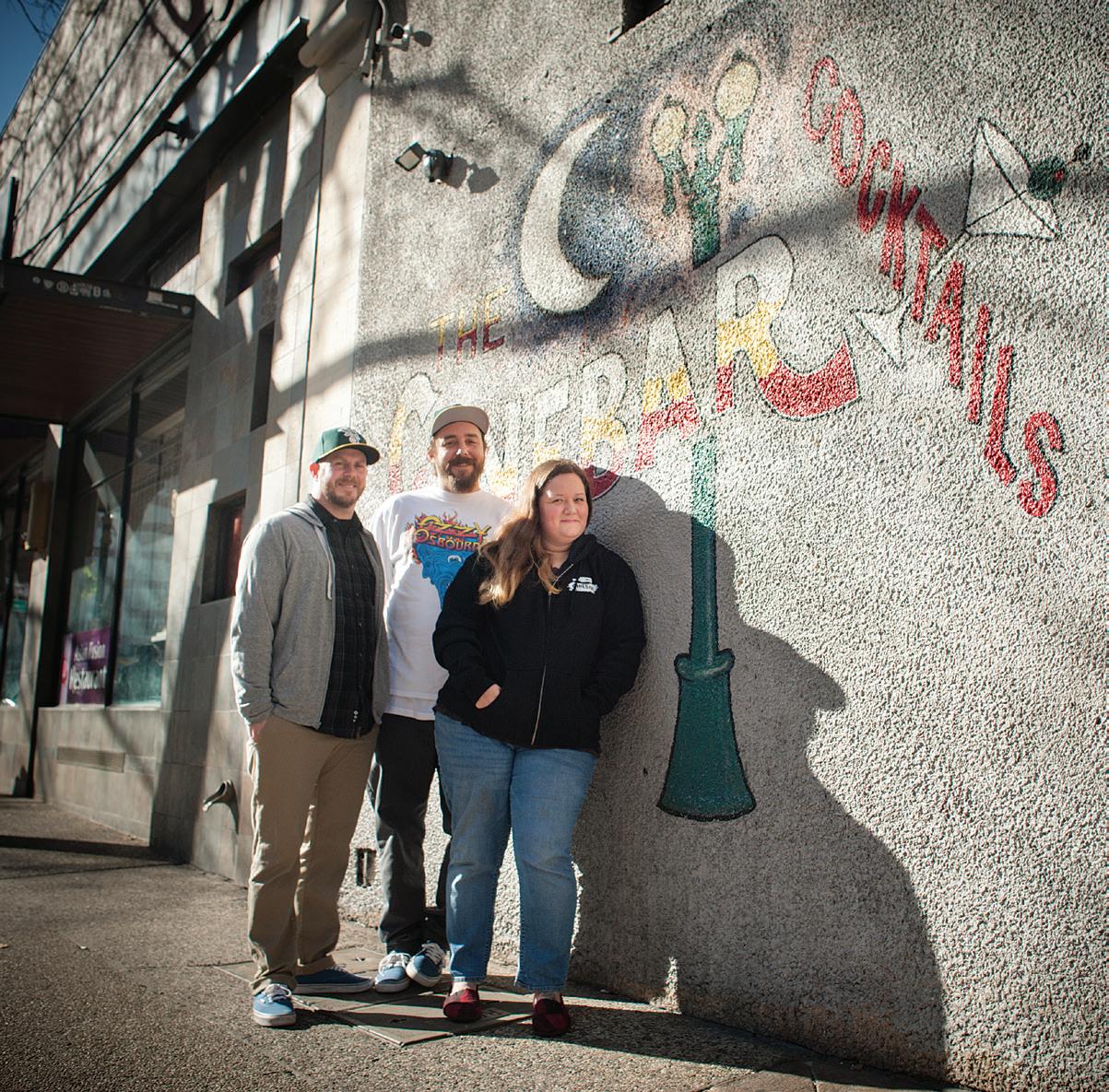
68
(L to R): Josh Hanoka, “Mad Mike” Matilainen, and Stacy Sutherland
CINEBAR
Written by Nathan Zanon Photography by Daniel Garcia
A NEW CHAPTER FOR AN OLD DIVE
Take a stroll down San Fernando Street in downtown San Jose and at first you might not notice Cinebar, a colorful watering hole that for years has been regarded by locals as one of the city’s best dive bars. Purportedly opened in 1928, it is one of the oldest drinking establishments in the South Bay, and although its narrow entrance and lack of windows make it easy to miss, it is home to an undeniable charm that keeps its patrons coming back for more.
Peer inside on any given night and you will likely find a cross section of San Jose itself: groups of college students and old-time barflies coalesce with skaters, hipsters, business leaders, and tech workers. Everyone is welcome; most mix and mingle. Locals are drawn to the unpretentious vibe of the place—not to mention the strong and inexpensive drinks.
But the recent history of the bar has been rocky. After the passing of longtime owner Sharon Polk in 2009 and her partner in 2011, Cinebar was left in financial limbo. Although technically managed by the Polk estate, many employees assumed operational duties to keep the place afloat. In 2014, however, the courts ordered the property be sold.
To the rescue came a group of three former staff members: Stacy Sutherland, “Mad Mike” Matilainen, and Josh Hanoka, who also owns Bray Butcher Block & Bistro in the San Pedro Square Market. After what Sutherland describes as a long “push and pull” with some competing potential buyers the trio began a new chapter for an old dive.
The first order of business was remodelling. “It was a matter of cleaning up,” Sutherland explains. “A lot of people were a little wary of what we were going to do.” Luckily, the process did not take long. Cinebar reopened in November with a whole new look. Raised ceilings give the space a more open feel and are complemented by mounted wall lamps crafted from upcycled mason jars—Sutherland’s personal handiwork. Wall panels that featured paintings of pop culture figures like James Dean, Bob Marley, and Frida Kahlo were removed
to make room for smaller works on canvas by artist Javier Ruiz, who created the original panels and is also one of the bartenders, and a collection of artfully designed skateboards. Many of the old paintings were auctioned off, but regulars were relieved to discover that an iconic Stormtrooper panel still hangs proudly in the back hallway.
“We’d like to eventually start doing art shows,” Sutherland says. “We’re trying to keep our flavor to it.” Cinebar is hoping to attract new customers without changing things too much—and so far the effort has been successful. The bar has become so busy that ownership has had to hire extra staff for the first time in quite a while.
Part of this success can be attributed to the familiarity ownership has with its clientele. Sutherland moved to San Jose at age 19 during the ’90s downtown revival. After bouncing around to several different jobs, she settled in at Cinebar, where she has worked for the past 12 years. Matilainen and Hanoka have also been around for about a decade. “It’s family,” Sutherland explains. “Having somebody else come in and take it over—I couldn’t let it happen. There was no way.”
The new owners continue to embrace the “dive bar” label—so much so that Sutherland bristles at the idea that the remodel has classed up the joint. “People come in and they’re like, ‘Oh, it’s a little swanky now,’ and I’m like, ‘Mmm, it’s not. It’s not.’ A little coat of paint didn’t make it swanky.”
Her excitement about this new business venture is evident. “I’m enjoying it, the whole ‘owner’ thing,” she says. But it is the support she has received from the community around her that really makes her beam. “It’s the people who make this place. People say, ‘Thank you for saving the bar,’ but it’s like— you guys saved this bar. Without you, we wouldn’t stay open.”
One thing is certain: even with the recent explosion of craft cocktail bars and expensive high-rise housing in the area, it is clear there is still room in San Jose for a good old-fashioned dive. Cheers to that.
instagram: cinebarsj
69
AT THE FAIR MONT
Photographer: Daniel Garcia
Art Director/Stylist: Elle Mitchell
Models: Asaba and Sydnie for Scout Models
Hair: Jade Deveraturda for Umbrella Salon
MUA: Diana Cortez
Production: Kristen Pfund
Wardrobe Styling: Rose Sellery and Tina Brown of Pivot: The Art of Fashion
Location: International Luxury Suite & Fountain Restaurant
Fairmont San Jose
170 South Market Street
San Jose, CA 95113

ASABA Shirt - Tobin W. Keller, tobinwkeller.com, $250

SYDNIE Dress - IB Bayo, ibbayo.com, $550

Heels - Yves Saint Laurent, Nordstrom Valley Fair, $895
Triangle Ring - Isharya, Isharya.com, $98
Bubble Ring - Isharya, Isharya.com, $68
Blue Shoes: Yves Saint Laurent, Nordstrom Valley Fair, $895


ASABA
Trousers - Tobin W. Keller, tobinwkeller.com, $250
Dress - Tobin W. Keller, tobinwkeller.com, $300 Coat - Six Crisp Days, Lotus Los Gatos, $160
Earrings - Isharya, Isharya.com, $198 Necklace - Isharya, Isharya.com, $288
Bracelets - Isharya, Isharya.com, $138 ea
Triangle Ring - Isharya, Isharya.com, $98
Bubble Ring - Isharya, Isharya.com, $68
 Frames - Abbot by Warby Parker, Warby Parker Santana Row, $145
SYDNIE
Frames - Abbot by Warby Parker, Warby Parker Santana Row, $145
SYDNIE

 SYDNIE Coat - Lotus, Lotus Los Gatos, $98 Earrings - Isharya, Isharya.com, $128
SYDNIE Coat - Lotus, Lotus Los Gatos, $98 Earrings - Isharya, Isharya.com, $128
ASABA
Jacket - IB Bayo, ibbayo.com, $1500

Shirt - Tobin W. Keller, tobinwkeller.com, $275
SYDNIE
Blouse - Lotus, Lotus Los Gatos $64
Heels - Valentino, Nordstrom Valley Fair, $995
Necklace - Isharya, Isharya.com, $318


Amanda Williamsen Envoy to Everything
Williamsen extols the populism of her art form. As a writer and public figure, she seeks purpose, humanity, and the right words for the sounds you notice when you’re making out by the lake.

What does a poet laureate do?
A poet laureate has a lot of fun. She or he works with libraries and other civic entities to bring the joys of poetry to the residents of the city. A poet laureate will host readings, hold contests, offer workshops, visit schools, participate in festivals, and honor community events with poems written for special occasions. She or he makes poetry come alive, showing many ways to be involved and enjoy this art form.
What is it about poetry that has led communities all over the world to adopt a poet laureate?
Perhaps it is because poetry is so approachable and immediate. You don’t need special equipment to join in this artistic conversation; you don’t need a paintbrush, or a violin, or the ability to balance on your toes while wearing a leotard, thank goodness. It’s more like this: can you write something, anything? A grocery list? A thank you card? Congratulations, you’re a poet. Seriously. Poetry is formed in the most unexpected ways and places. It elevates the pedestrian.
Audre Lorde said, “Poetry is not only dream and vision; it is the skeleton architecture of our lives. It lays the foundations for a future of change, a bridge across our fears of what has never been before.” What kind of change do you hope to see made in the world through poetry?
Well, that’s a tall order for poetry. But I believe poetry can effect individual change. We can look within ourselves to our deepest feelings, identifying, perhaps, our motivations, and we can also identify our values. It can let us lead a more purposeful life, pursuing, I hope, our goals while being aware of the humanity of others. Wouldn’t the world be a nicer place if we were all more emotionally articulate?
What need does poetry serve?
It serves the need to formalize, emphasize, honor, and beautify our experiences. Sometimes it serves the need to give voice to anger and grief.
Do you have any other talents?
I play the clarinet. And bake pies. And sew. And I quilt in a hasty, explosive, “I need no pattern!” kind of way. My quilts are wrinkly, but I like my compositions of texture and color. My relatives display them when I visit. I’m not sure what they do with them when I’m gone....
80
Cupertino’s new Poet Laureate, Amanda Williamsen
Interview by David Perez Photography by Daniel GArcia
INTERLOCHEN, MICHIGAN
There are stars, a lake, shining fish in the water. In the reeds along the shore, frogs are sweetly beeping, all around, all night.
I am the camp counselor making out on the dock with the skinniest lifeguard; I am sneaking out to meet him, skittering through the administration building in my nightgown and nobody sees me; I am the princess of the wishing well, Audrey Hepburn in Roman Holiday Days, doves hootie-hoo in the pines. I walk with that lifeguard through the deep woods to a place where ten years ago a tornado lay all the trees down flat and stirred them like scattered matches. Brambles loop the logs
like Victorian rolling hoops: there raspberries swell red and tangy, sun-warmed. Brightness colors our hands.
Have I ever been so happy? In the staff room, we put our laundry in the same washing machine. My underwear, swirling around with his underwear.
It is too much. In August I am a girl again alone by a stream in the tornado zone, watching damselflies struggle on the quivering surface. Again and again they connect, and trout pluck them from between yellow lilies. Moreover, it’s hot, and the air is fetid with too much pollen. I am learning to speak Spanish now for a camper from Venezuela; she is far from home and wants to throw up. The other girls stare as she sobs in the bottom of her sleeping bag. I kneel beside her, rub the puffy lump in slow circles. Quiero vomitar, she says. Quiero a mi mamá.

Published in Midwestern Gothic, Winter 2014 81 cupertinopoetlaureate.org facebook: Cupertino-Poet-Laureate
Amanda will be reading with Jennifer Swanton Brown, Cupertino’s previous Poet Laureate, at Florey’s Books in Pacifica on March 26, at 7:30pm.
CURIOUS QUAIL
THE BAY'S LEADING CHIPTUNE, ORCHESTRAL ROCK BAND
If you combine the energy of rock music, the nostalgia of chiptunes created on old Gameboys, and the intricacy of symphonies, you end up with Curious Quail. Everything from the clean vocals to the tight drum rhythms, fuzzy guitars, eight-bit bee-boops, and soaring violin riffs are thoughtfully worked into carefully layered songs that capture your attention and lift your spirit. Even Quail’s lyrics are carefully crafted stories observing futuristic human society, which started out as frontman Mike Shirley-Donnelly’s idea for a novel before he decided to turn into concept albums.
Yet as unique and innovative as they are, from their sound to the mysterious name, Curious Quail never strived to be intentionally different. “From the get-go, this was how I wrote the first album,” Shirley-Donnelly says, remembering the first Curious Quail EP titled The GLOW. “I wanted to do loud, fuzzy guitar stuff, little bleeps, bloops, and also the symphonic side of that with string samples. I mixed them together, made five songs, and I was like, ‘Cool, this is what I sound like!’ ”
Curious Quail’s roots began in 2008 with singersongwriter Shirley-Donnelly and his Gameboy, “the second member of the band,” jokes drummer Joey Guthrie, who joined Shirley-Donnelly not long after. Guthrie’s high school friend Alan Chen, a violinist, joined about a year later. The three remained core members in Quail’s lineup as the band continued to grow, boasting as many as eight members before condensing into a serious five-piece in 2013. Quail retains a high level of musicianship-–most members have symphonic backgrounds and some even music degrees. The current rendition of the band also includes guitarist Joyce Kuo, one of the Bay’s hardest-working musicians, as well as the band’s newest addition, Josh Hotlosz, former bassist of San Jose’s Koruscant Weekend, which split up in 2013.
Still, even with so much transition, Quail has stayed true to its roots, keeping Shirley-Donnelly’s original vision at its core. Shirley-Donnelly traces the chiptune and symphonic influences back to when he was growing up playing video games on Atari and Nintendo systems in the ’80s. “I would
listen to the soundtrack of a video game I grew up with and realize, ‘My god, that was literally just four notes,’ ” ShirleyDonnelly recalls, laughing, “but in my head it sounded like this crazy symphony. I wanted to re-create that.”
“I think of the chips as keyboards,” Guthrie adds, noting that “in a lot of other bands, [the chips] are sort of the backdrop to the rest of the song, but in our band they play a role like a synth would.”
But even with the chiptunes as a foundation for their music, Curious Quail finds ways to spread their wings and evolve their sound. “There is nothing signature about Quail except Mike’s voice, the chips, and the lyrical content’s ongoing storyline,” says Guthrie, “which frees me up to go, ‘What if I put double bass here?’ or Alan to go, ‘What if I throw a Doctor Who reference into this song?’ ”
Meanwhile, Chen adds his own flavor and references, incorporating past melodies into newer songs as “Easter eggs” that also help tie the concept albums together. “We like to call Alan ‘the concertmaster,’ ” jokes Shirley-Donnelly, explaining Chen’s ear for harmonizing and mixing parts together. “He thinks about things from an orchestral point of view, [telling] us how some 19th-century composer would have written it.”
Kuo has also found her own freedom in Quail as the band’s first true lead guitarist. “Joyce plays very differently from me, and on a level I’ll never be able to,” Shirley-Donnelly remarks, “She has her own way of making things sound good so we’re not doubling up.”
Even Hotlosz has already found his own flavor to add to the mix with his extensive pedal board, a less-common practice among bassists. “Thundercat the bassist said it best,” Hotlosz laughs. “He said, ‘A lot of people see the bass like a tool. I see it as a weapon. You could use it to hammer a nail, or to bash someone’s skull in.’ It’s my weapon of choice.”
Curious Quail continues “to constantly crescendo into better things,” Guthrie says. For them, as long as there is still story to write and people to play with, Quail’s flight won’t end—they’ll just keep going as different musicians come and go, and new opportunities arise.
Written by Giselle Tran Photography by Jessica Shirley-Donnelly
82
I WANTED TO DO LOUD, FUZZY GUITAR STUFF, LITTLE BLEEPS, BLOOPS, AND ALSO THE SYMPHONIC SIDE OF THAT WITH STRING SAMPLES. I MIXED THEM TOGETHER, MADE FIVE . SONGS, AND I WAS LIKE, ‘COOL, THIS IS WHAT I SOUND LIKE!’ ”
__Mike Shirley-Donnelly

curiousquail.com social media: CuriousQuail 83
Alan Chen Josh Hotlosz Mike Shirley-Donnelly
Joyce Kuo Joey Guthrie
“
gatherings for culture creatives
Content LAB kicked off the New Year with rave excitement as a notably style-conscious crowd filtered into Kit and Ace in Santana Row for an evening of “Sushi & Style.”
DJ Thomas Ramon Aguilar, musicologist and owner of Universal Grammar, set the mood for the night, spinning an upbeat set. Meanwhile, luxury fashion retailer Kit and Ace invited Content LAB guests to gather around their supper table, where they host quarterly community dinners. Guests enjoyed gyoza bites, wine, Sapporo beer, and sake as they donned aprons in anticipation of a culinary lesson.
Chef Michi greeted the crowd and made a toast (kampai!) before leading a demonstration for crafting the perfect sushi hand roll. The tables were set with fresh veggies, seafood, rice, and seaweed for guests to customize their hand rolls with the aid of Michi’s skilled catering team.
Fashion industry insider Suzanne Garcia-McAtee shed light on her role as the former general merchandise manager of Bebe and regional merchandise manager of Nordstrom. The crowd learned about the process of conceptualizing trends months in advance and seeing them to a finished product. An enticing Q&A followed as Suzanne answered questions concerning wardrobe staples, fashion faux-pas, and advice for breaking into the industry.
Stylist Justin Weatherford took the floor to share more about the versatile products and community of Kit and Ace. By highlighting the local talent of designers, artists, and tastemakers, Kit and Ace’s retail space mirrors the innovative ethos of the brand’s wearable luxury fabrics.
Guests were then treated to a raffle drawing presented by fashion bloggers Monica CruzHernandez of Living in Vogue and Grace Jeramie of My Style and Grace. Winners went home with copies of Matt Goulding’s Japanese foodie memoir, Rice, Noodle, Fish; 18k gold-plated jewelry by Isharya; and a hand-picked Kit and Ace shirt. The two bloggers also curated a selection of covetable pieces around the store. The evening continued with music, mingling, and many guests sporting traditional kimonos provided by Chef Michi and his team. “Sushi & Style” proved to be a valuable example of good taste in the company of creative individuals.
A big thank you to our event partners: Knight Foundation, Kit and Ace, Michi Catering, Thomas Ramon Aguilar, Suzanne Garcia-McAtee, Monica Cruz-Hernandez, Grace Jeramie, Liquid Bread, Isharya, Mach 7 Sound, and ANML.
Stay tuned for more information on the next Content LAB: THE PHOTO SHOP March 19, 2016 10am-1pm
LAB
84






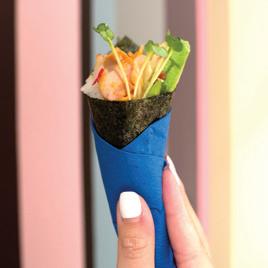



85
Written by Jessica Owens
Photography by Stan olszewski
M W SU T
The End of Time
13
Cellista (Freya Seeburger) presents a performance that incorporates the artwork of renowned visual artist Barron Storey into an immersive setting for the music of French composer Olivier Messiaen.
Anno Domini artful.ly/theendoftime
West Coast Swing Party Dance until midnight with host Richard Kear. Evening includes optional beginner and intermediate drop-in classes before the party.
Dance Boulevard Weekly danceboulevard.com
7
Cinequest
A showcase of premier films, renowned and emerging artists, and breakthrough technology, this 13-day festival empowers global connectivity between creators, innovators, and audiences.
Downtown San Jose Mar 1–13 cinequest.org
1
Cafe Lift Open Mic
2
Cafe Lift is an open mic and open canvas night, providing an awesome atmosphere for musicians, poets, and artists of all types to perform for a supportive audience.
Cafe Lift
Every 2nd Wed cafeliftsj.com
Jonathan Kreisberg & David Kikoski Duo Guitarist/composer Jonathan Kreisberg and keyboardist/ composer David Kikoski will fill Cafe Pink House, a fresh live music venue in Saratoga, with modern jazz.
Cafe Pink House cafepinkhouse.com
24
Artist Laureate Reception
11
Join SVCreates in honoring the 2016 Artist Laureates. Meet members of the creative community as you enjoy drinks, appetizers, and a short program celebrating these amazing artists.
Mexican Heritage Plaza svcreates.org
24
South First Street transforms to host an all-day music festival with three outdoor stages, ten indoor stages, and a hundred acts, plus art and vendors.
San Jose SoFA District Facebook: SoFAstreetFair
The Comedy of Errors ShakesBEERience combines beer, food, and a staged reading. Professional actors will unpack the language of The Comedy of Errors in a playful, unique, and accessible way.
25 SoFA Street Fair
Cafe Stritch Facebook: BuckHillProductions
12
Is the newspaper photo of a deceased man Corrie’s estranged brother? Corrie travels to San Francisco to find out. Watch this reading of a new play, then interaction with the playwright.
City Lights Theater cltc.org
Tokyo Fish Story
9 New Play Readers Series: Taken
This warm-hearted comic drama, in which a revered sushi master struggles to preserve ancient artistry in a society obsessed with change, was a highlight of TheatreWorks’ New Works Festival.
Lucie Stern Theatre Mar 9–Apr 3 theatreworks.org
86
TH F S
The Changing Same
Art inspires art at this annual event sponsored by SJMA and Poetry Center San Jose. Every year, SJMA invites Bay Area poets to visit and create poems inspired by the artworks on view.
7th
Art inspires art at this annual event sponsored by SJMA and Poetry Center San Jose. Every year, SJMA invites Bay Area poets to visit and create poems inspired by the artworks on view.
Rockage 5.0
11
This three-day celebration of indie music and retro gaming features live bands, DJs, freeplay classic arcade, gaming tournaments, movies, prizes, and more.
Downtown San Jose Mar 11–13 rockagesj.org
Content LAB
The Photo Shop
19
Hands-on opportunity for instruction in the key elements of great photography, including theory of composition and light design. Tickets required content-magazine.com
11
’57 Chevy Ric Salinas of Culture Clash stars in this one-man comedy chronicling the misadventures of “double immigrants” who moved from their homelands to the US barrios before moving up into the suburbs.
MACLA Mar 11–13 maclaarte.org
Bodies of Technology
25
Top-flight choreographers and company dancers explore the convergence of technology with art, music, and movement.
San Jose Center for the Performing Arts Mar 25–27 siliconvalleyballet.org
Bay Area National Dance Week
22
Celebrate dance in all its forms with hundreds of free events throughout the Bay Area, including classes, performances, open rehearsals, lecture demonstrations, and more. Various Bay Area Locations Apr 22–May 1 bayareandw.org
Midnight Ride to Pee-Wee
Join Cowgirl Bike Courier for a night of cycling, shenanigans, and popcorn. Assemble in front of the theater at 10pm, leave for a ride at 10:30pm, and return for the 11:55pm showing.
Camera 3 facebook.com/cowgirlbikecourier
Bay Area Printers’ Fair & Wayzgoose
9
Print enthusiasts, students, educators, graphic designers, typophiles, artists, and printers new or old will enjoy the demonstrations, tours, and array of vendors and exhibitors.
History Park printersguild.wordpress.com
A Streetcar Named Desire
16
The famous Tennessee Williams play, set in 1940s New Orleans, gets the operatic treatment in this San Jose premiere.
California Theatre Apr 16–May 1 operasj.org
To have your event considered for listing, send to: press@content-magazine.com
March/APRIL
COntent Calendar #ContentPick
26
Annual Poetry Invitational
87
San Jose Museum of Art sjmusart.org 21
21
The Continental Bar Weekly thecontinentalbar.com
CINEQUEST SURVIVAL GUIDE 2016
Written by Nathan Zanon
Planning to be in San Jose between March 1 and March 13 for the 26th Annual Cinequest Film Festival? The popular event features hundreds of films, forums, events, and parties at venues throughout downtown. It can be overwhelming, but to make planning easier, here’s a breakdown of what you shouldn’t miss.
OPENING AND CLOSING NIGHTs: The festival is bookended by the Opening and Closing Night films at the gorgeous California Theatre, followed by the respective after-parties. On Opening Night—Tuesday, March 1—catch Eye in the Sky starring Helen Mirren, followed by the after-party at the Farmers Union. Finish your Cinequest festivities on Sunday, March 13, with the blowout Closing Night party at the newly reopened Hammer Theatre (formerly the San Jose Rep).
MAVERICK SPIRIT AND MEDIA LEGACY AWARDS: Each year, the festival hands out special awards honoring creative vision, independence, and leadership in filmmaking. This year actor/ director James Franco will receive a Maverick Spirit Award, and film critic Owen Gleiberman will speak at a Media Legacy Award screening of one of his favorite movies, Manhunter
DAY OF THE WRITER: The Day of the Writer brings a series of panels and events that focus on the process of writing. Panelists include working TV and film scribes, producers, and others. The day also incorporates Cinequest’s Screenplay Competition, where screenwriters get a chance to pitch their stories live on stage.
FUTURE OF FILM SHOWCASE : Cinequest is known for tapping in to the latest technological advances related to the movie experience, and the Future of Film Showcase gives visitors a taste of everything from mobile cinema to VR (virtual reality). Don’t miss a rough-cut screening of the locally
made feature Mr. Invincible (written by previous Cinequest Screenplay Competition winner Stacie Shellner) showing on massive, three-paneled Barco Escape screens.
FEATURES AND SHORT FILM PROGRAMS: With hundreds of films— including close to 50 world-premiere features and dozens of shorts you’ll never have a chance to see again—there will be a lot to choose from. Spotlight Films, which screen each evening at the California Theatre, are a good place to start, while documentaries and international features tend to be the critical darlings. Any of Cinequest’s short film programs is recommended.
STUDENT FILMS: The student film competition at Cinequest has always been a highlight, but this year the festival is giving these future filmmakers a bigger platform. Look for two short-film showcases for the College Film Competition plus a High School Film Competition shorts program, as well as expanded forums and educational opportunities that will connect aspiring youngsters to industry pros.
PARTY EVERY DAY: Each evening during the festival, a different local bar or restaurant hosts the Maverick Meetup and the VIP Soirée (you need to secure a VIP badge to attend the latter). These gatherings are a perfect way to mingle with fellow film lovers and meet the people behind the films and the festival.
cinequest.org
facebook: Cinequest
instagram: cinequestinc
twitter: cinequest
88
Thank You
This issue is made possible with the support of our partners—companies and organizations who share our desire to support and develop the creative community of the South Bay. We are grateful for their contribution and support and for actively taking part in the betterment of our region.
For more information on becoming a mission partner, contact daniel@content-magazine.com
Knight Foundation supports transformational ideas that promote quality journalism, advance media innovation, engage communities and foster the arts. We believe that democracy thrives when people and communities are informed and engaged.
Knight is working to support the urbanization of a traditionally sprawling city with a specific focus on Central San Jose. Our investments tap into the region’s creative energy and disruptive history to accelerate the city’s significance as a well-connected, transport-accessible hub for culture and innovation in the South Bay.
Working with partners in the public and private sectors, we support a range of projects from prototypes and popups to in-depth research and sustained organizational support.
www.knightfoundation.org
THAnK YOU
Filco Events has been working on festivals, fundraisers, and events in the San Francisco Bay Area since 1988. Each event is individually tailored to the special needs and goals of the organization. While fundraising is always a significant part of festivals, other priorities include media attention, corporate support, and volunteer building, as well as the opportunity to showcase specific programs and services to the community.
In all cases, advancing long-term goals while still raising significant revenue gives each event purpose and recognition for many years into the future. From logistics to concessions to volunteer coordination, we can contract key elements of large festivals, provide consultation, or actually direct the entire production. We are also available for national and multi-city events. filco.com
THAnK YOU
Proud Sponsor of Content Magazine Pick-Up Parties for 2016
Michi Catering has been passed down from generation to generation: from Mr. Michi Shin to first son Mike, and now to Raphael, a recent business graduate of Loyola Marymount University. The opportunity to work across generations, drawing from the knowledge and insights of each, is what enables the Michi brand to consistently, creatively, and expertly innovate Asian-American cuisine in the Bay Area.
With a strong network of valued partners, Michi is able to provide a full-service event experience to accommodate every logistical and operational need: menu design, cuisine, beverages, production, photography, cinematography, floral arrangements, staffing, equipment rentals, and more. We offer our services for weddings, private parties, corporate luncheons, team-building events, wine-pairing dinners, sake-pairing dinners, cooking-demonstrations, and elegant private dinner services.
Our main catering clients and partners include Netflix, Ebay, PayPal, Cisco, Samsung, Dolby, Apple, HP, Intel, PWC, Ernst & Young, Oracle, and Adobe.
michilife.com
THAnK YOU
The Sound In Motion Entertainment Group company founders and 17-time Best DJ reader-poll winners “DJ Adrian” Cavlan and “King Raffi” Nalvarian (of Mix 106.5 and Live 105 radio fame) passionately run what they believe is one of the top DJ and video companies you will find anywhere. They have emerged as nationally recognized industry leaders who have been asked to give presentations across the country on the art and business of being a DJ and Master Of Ceremonies.
The staff at Sound In Motion is a reflection of everything Raffi and Adrian value and practice in their company: it starts with commitment and genuine caring, continues with charisma and enthusiasm, and ends with services joyfully delivered and promises proudly kept.
If you are planning an event in our area, you will soon start noticing our name appearing on most venue-provided Preferred Vendor lists. We are proud that we have earned this privilege by providing a consistently high level of quality, one that is valued by clients and fellow event professionals alike.
THAnK YOU
soundinmotioneg.com
Kit and Ace is a luxury fashion retailer with a local in-store design team whose mission it is to disrupt the market by showing what is possible when designing products to be seamless, luxurious, and time saving. Products, in other words, to truly benefit consumers.
Ever future-focused, Kit and Ace makes it a practice to seek out the newest systems, fabrics, tools, construction, and care, with an eye always toward improving upon excellence. As they expand, the company continues to look for ways to stay local. For each location, in addition to the local in-house product team, Kit and Ace works with local artists and businesses to design their stores—from fixtures and furnishing to lighting and artwork. Each store is thus both wholly distinctive and perfectly fitted to its community. For each location as well, Kit and Ace hosts an innovative supper club, quarterly dinners designed to support and engage the surrounding community.

kitandace.com THAnK YOU
Telly Award–winning Tabrizi Productions is downtown

San Jose’s leader in event and commercial videography. Led by Farran Tabrizi, the company has expanded quickly since its introduction to San Jose’s SoFA district. Combining a creative eye with expert editing, Tabrizi Productions excels at capturing what makes your product or event special. Our team has produced online advertisements, instructional videos, music videos, and TV shows, and covered weddings, nonprofit events, festivals—and everything else in between.
Universal Grammar (UG) is a boutique production house that presents quality artistry from emerging contemporary voices. As an ambassador for modern cultural creativity, UG curates offerings that reveal a devotion to authentic artistry that both challenges modern convention and respects its craft.
instagram: Chatos1013 twitter: UnGrammar
tabriziproductions.com
Thomas Ramon Aguilar, aka Chatos1013 Selector | Musicologist | Curator | Owner of Universal Grammar
THAnK YOU
Contributors
The production of Content Magazine would not be possible without the talented writers, editors, graphic artists, and photographers who contribute to each issue. We thank you and are proud to provide a publication to display your work. We are also thankful for the sponsors and readers who have supported this magazine through advertisements and subscriptions.
Want to be a part of the Content community?
Contact us at: Editor@content-magazine.com
ELLE MITCHELL
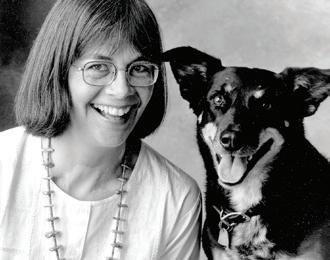
As an art and design student at SJSU, Elle spends much of her time creating. Her passions include clean typography, creative packaging, and photographs that tell a story. You will probably find her in a coffee shop. instagram: elleirene
KATE

Kate is a freelance writer and North Carolina native. A recent San Jose transplant, she enjoys learning about the city’s history and rich heritage, exploring farmers markets, finding the best wine tasting spots, and making San Jose home after living abroad in Europe and Africa.
VILA SCHWINDT
Vila wears many hats: editor, writer, wife, jazz fan, gardener, church lady. Her home turf includes the Bay Area, Colorado, and New Mexico. She enjoys words, fine cuisine, whiskey, and horses.
Julia is a performing artist, arts administrator, budding web developer, and social media ninja who loves dance, history, film, and geek culture. She is a marketing co-chair for genARTS Silicon Valley, board member for PUSH Dance Company, and dancer for High Release Dance Company and Natasha Carlitz Dance Ensemble.

COVER IMAGE
Black Sheep Brasserie’s interior designer, Gail Salice, commissioned and worked with artist Marcia DeRosa to paint the perfect piece to complete the restaurant’s decor.
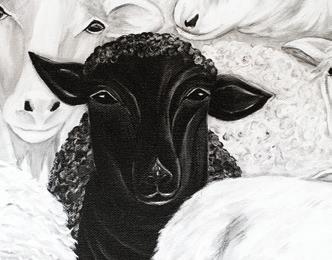
Gail Salice Interiors g_s_interiors@yahoo.com
A San Jose native, Brandon E. Roos is a contributing writer to Content, KQED Arts, and Metro. His work often examines the creative voices helping to shape and inspire a more vibrant South Bay.


twitter: busstophustle busstophustle.tumblr.com
JOEY
Joey is a restaurateur in training. His passion for food, photography, and social media has led him around the world in search of the finest foods, but at the end of the day even little things such as a well-made PB&J can satisfy. Recently, he opened Poki Bowl and The Poke Lab in Monterey. thepokelab.com
Kristen is a producer and creative consultant in the Bay Area, with a split interest in the art of film and photography. As an avid international traveler, she’s compelled to tell cultural, visual stories that are both thought-provoking and empower people to take action.
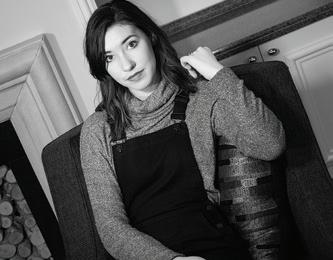
instagram: kristen_pfund
 EVANS
KRISTEN PFUND
BRANDON ROOS
NGUYEN
Julia Canavese
EVANS
KRISTEN PFUND
BRANDON ROOS
NGUYEN
Julia Canavese
96










www.sanjosecultur e.or g Dan Corson, Sensing You, 2015 Downtown San Jose Highway 87 Underpass at Santa Clara Street City of San Jose Office of Cultural Affairs Public Art Program P h o t o c r e d i t : D a n C o r s o n CREATE : CONNECT : SAN JOSE 116-CITY OF SAN JOSE.qxp_Layout 1 12/17/15 2:47 PM Page 1

CONTENT NEXT ISSUE Sight and Sound 8.1 SAN JOSE 2016 WWW.CONTENT-MAGAZINE.COM social media: contentmag ANNuAl SubSCripTiON priNT $42.00 silicon valley’S INNOVATIVE & CREATIVE CULTURE made in sanjose, ca join subscribe www.content-magazine.com






































































 Lunacy
Lunacy


 Written by leah Ammon Photography by Daniel Garcia
Written by leah Ammon Photography by Daniel Garcia






























 Top: Still from The Yellow Wallpaper
Top: Still from The Yellow Wallpaper
 Chris Neale, Executive Vice President
Chris Neale, Executive Vice President

















 Interview and Photography by Daniel Garcia
Interview and Photography by Daniel Garcia


 Erik Natzke Principal Artist-in-Residence
Erik Natzke Principal Artist-in-Residence










 Stephen Shelton
Philippe Breneman
Jimmy Marino
Stephen Shelton
Philippe Breneman
Jimmy Marino

















 Frames - Abbot by Warby Parker, Warby Parker Santana Row, $145
SYDNIE
Frames - Abbot by Warby Parker, Warby Parker Santana Row, $145
SYDNIE

 SYDNIE Coat - Lotus, Lotus Los Gatos, $98 Earrings - Isharya, Isharya.com, $128
SYDNIE Coat - Lotus, Lotus Los Gatos, $98 Earrings - Isharya, Isharya.com, $128

























 EVANS
KRISTEN PFUND
BRANDON ROOS
NGUYEN
Julia Canavese
EVANS
KRISTEN PFUND
BRANDON ROOS
NGUYEN
Julia Canavese












